Document 25
Exhibit 99.1
Phreesia Announces Fourth Quarter Fiscal 2025 Results
ALL-REMOTE COMPANY/WILMINGTON, Del. – March 12, 2025 – Phreesia, Inc. (NYSE: PHR) (“Phreesia” or the "Company") announced financial results today for the fiscal fourth quarter and fiscal year ended January 31, 2025.
"We are pleased with our solid finish to fiscal 2025 and I am excited about the new products we have introduced over the past several quarters that improve medication adherence and the overall patient and provider experience," said CEO and Co-Founder Chaim Indig.
Please visit the Phreesia investor relations website at ir.phreesia.com to view the Company's Q4 Fiscal 2025 Stakeholder Letter.
Fiscal Fourth Quarter Ended January 31, 2025 Highlights
•Total revenue was $109.7 million in the quarter, up 15% year-over-year.
•Average number of healthcare services clients ("AHSCs") was 4,341 in the quarter, up 10% year-over-year.
•Total revenue per AHSC was $25,266 in the quarter, up 5% year-over-year. See "Key Metrics" below for additional information.
•Healthcare services revenue per AHSC was $17,616 in the quarter, up 1% year-over-year. See "Key Metrics" below for additional information.
•Net loss was $6.4 million in the quarter, as compared to $30.6 million in the same period in the prior year.
•Adjusted EBITDA1 was $16.4 million in the quarter, as compared to negative $3.5 million in the same period in the prior year.
•Net cash provided by operating activities was $16.3 million in the quarter, as compared to net cash used in operating activities of $3.1 million in the same period in the prior year.
•Free cash flow2 was $9.2 million in the quarter, as compared to negative $10.9 million in the same period in the prior year.
•Cash and cash equivalents as of January 31, 2025 was $84.2 million, up $2.5 million from October 31, 2024.
Fiscal Year Ended January 31, 2025 Highlights
•Revenue was $419.8 million in fiscal 2025, up 18% year-over-year.
•AHSCs were 4,203 in fiscal 2025, up 17% year-over-year.
•Total revenue per AHSC was $99,884 in fiscal 2025, up 1% year-over-year. See "Key Metrics" below for additional information.
•Healthcare services revenue per AHSC was $70,961 in fiscal 2025, down 2% year-over-year. See "Key Metrics" below for additional information.
•Net loss was $58.5 million in fiscal 2025, as compared to $136.9 million in fiscal year 2024.
•Adjusted EBITDA1 was $36.8 million in fiscal 2025, as compared to negative $35.4 million in fiscal 2024.
•Net cash provided by operating activities was $32.4 million in fiscal 2025, as compared to net cash used in operating activities of $32.4 million in fiscal 2024.
•Free cash flow2 was $8.3 million in fiscal 2025, as compared to negative $57.5 million in fiscal 2024.
•Cash and cash equivalents as of January 31, 2025 was $84.2 million, down from $87.5 million as of January 31, 2024.
1 Adjusted EBITDA is a non-GAAP measure. We define Adjusted EBITDA as net loss before interest income, net, provision for income taxes, depreciation and amortization, stock-based compensation expense, loss on extinguishment of debt and other income, net. See “Non-GAAP Financial Measures” for a reconciliation of Adjusted EBITDA to the closest GAAP measure.
2 Free cash flow is a non-GAAP measure. We define Free cash flow as net cash provided by (used in) operating activities less capitalized internal-use software development costs and purchases of property and equipment. See “Non-GAAP Financial Measures” for a reconciliation of Free cash flow to the closest GAAP measure.
Fiscal 2026 Outlook
We are maintaining our revenue outlook for fiscal 2026. We expect revenue to be in the range of $472 million to $482 million. The revenue range provided for fiscal 2026 assumes no additional revenue from potential future acquisitions completed between now and January 31, 2026.
We are maintaining our Adjusted EBITDA outlook for fiscal 2026. We expect Adjusted EBITDA to be in the range of $78 million to $88 million. The Adjusted EBITDA range provided for fiscal 2026 assumes continued improvements in operating leverage across the Company through a focus on efficiency.
We are maintaining our expectation for AHSCs to reach approximately 4,500 in fiscal 2026. Additionally, we expect total revenue per AHSC in fiscal 2026 to increase from fiscal 2025.
We believe our $84.2 million in cash and cash equivalents as of January 31, 2025, along with cash generated in our normal operations, gives us sufficient flexibility to reach our fiscal 2026 outlook. Additionally, our available borrowing capacity under our credit facility with Capital One provides us with an additional source of capital to pursue future growth opportunities not incorporated into our fiscal 2026 outlook. As of January 31, 2025 we had no borrowings outstanding under our credit facility.
Non-GAAP3 Financial Measures
We have not reconciled our Adjusted EBITDA outlook to GAAP Net income (loss) because we do not provide an outlook for GAAP Net income (loss) due to the uncertainty and potential variability of Other (income) expense, net and (Benefit from) provision for income taxes, which are reconciling items between Adjusted EBITDA and GAAP Net income (loss). Because we cannot reasonably predict such items, a reconciliation of the non-GAAP financial measure outlook to the corresponding GAAP measure is not available without unreasonable effort. We caution, however, that such items could have a significant impact on the calculation of GAAP Net income (loss). For further information regarding the non-GAAP financial measures included in this press release, including a reconciliation of GAAP to non-GAAP financial measures and an explanation of these measures, please see “Non-GAAP financial measures” below.
Available Information
We intend to use our Company website (including our Investor Relations website) as well as our Facebook, X, LinkedIn and Instagram accounts as a means of disclosing material non-public information and for complying with our disclosure obligations under Regulation FD.
Forward-Looking Statements
This press release includes express or implied statements that are not historical facts and are considered forward-looking within the meaning of Section 27A of the Securities Act of 1933, as amended and Section 21E of the Securities Exchange Act of 1934, as amended. Forward-looking statements generally relate to future events or our future financial or operating performance and may contain projections of our future results of operations or of our financial information or state other forward-looking information. These statements include, but are not limited to, statements regarding: our future financial and operating performance, including our revenue, operating leverage, margins, Adjusted EBITDA and cash flows; our ability to finance our plans to achieve our fiscal 2026 outlook with our current cash balance and cash generated in the normal course of business; and our outlook for fiscal 2026, including our expectations regarding revenue, Adjusted EBITDA, AHSCs and Total revenue per AHSC. In some cases, you can identify forward-looking statements by the following words: “may,” “will,” “could,” “would,” “should,” “expect,” “intend,” “plan,” “anticipate,” “believe,” “estimate,” “predict,” “project,” “potential,” “continue,” “ongoing,” or the negative of these terms or other comparable terminology, although not all forward-looking statements contain these words. Although we believe that the expectations reflected in these forward-looking statements are reasonable, these statements relate to future events or our future operational or financial performance and involve known and unknown risks, uncertainties and other factors that may cause our actual results, performance or achievements to be materially different from any future results, performance or achievements expressed or implied by these forward-looking statements. Furthermore, actual results may differ materially from those described in the forward-looking statements and will be affected by a variety of risks and factors that are beyond our control, including, without limitation, risks associated with: our ability to effectively manage our growth and meet our growth objectives; our focus on the long-term and our investments in growth; the competitive environment in which we operate; our ability to comply with the covenants in our credit agreement with Capital One; changes in market conditions and receptivity to our products and services; our ability to develop and release new products and services and successful enhancements, features and modifications to our existing products and services; our ability to maintain the security and availability of our platform; the impact of cyberattacks, security incidents or breaches
3GAAP is defined as generally accepted accounting principles in the United States.
impacting our business; changes in laws and regulations applicable to our business model; our ability to make accurate predictions about our industry and addressable market; our ability to attract, retain and cross-sell to healthcare services clients; our ability to continue to operate effectively with a primarily remote workforce and attract and retain key talent; our ability to realize the intended benefits of our acquisitions and partnerships; and difficulties in integrating our acquisitions and investments; and other general, market, political, economic and business conditions (including from the results of the 2024 U.S. presidential and congressional elections and the warfare and/or political and economic instability in Ukraine, the Middle East or elsewhere). The forward-looking statements contained in this press release are also subject to other risks and uncertainties, including those listed or described in our filings with the Securities and Exchange Commission (“SEC”), including in our Annual Report on Form 10-K for the fiscal year ended January 31, 2025 that will be filed with the SEC following this press release. The forward-looking statements in this press release speak only as of the date on which the statements are made. We undertake no obligation to update, and expressly disclaim the obligation to update, any forward-looking statements made in this press release to reflect events or circumstances after the date of this press release or to reflect new information or the occurrence of unanticipated events, except as required by law.
This press release includes certain non-GAAP financial measures as defined by SEC rules. We have provided a reconciliation of those measures to the most directly comparable GAAP measures, with the exception of our Adjusted EBITDA outlook for the reasons described above.
Conference Call Information
We will hold a conference call on Wednesday March 12, 2025, at 5:00 p.m. Eastern Time to review our 2025 fiscal fourth quarter and fiscal 2025 financial results. To participate in our live conference call and webcast, please dial (800) 715-9871 (or (646) 307-1963 for international participants) using conference code number 7404611 or visit the “Events & Presentations” section of our Investor Relations website at ir.phreesia.com. A replay of the call will be available via webcast for on-demand listening shortly after the completion of the call, at the same web link, and will remain available for approximately 90 days.
About Phreesia
Phreesia is a trusted leader in patient activation, giving healthcare providers, life sciences companies and other organizations tools to help patients take a more active role in their care. Founded in 2005, Phreesia enabled approximately 170 million patient visits in 2024—1 in 7 visits across the U.S.—scale that we believe allows us to make meaningful impact. Offering patient-driven digital solutions for intake, outreach, education and more, Phreesia enhances the patient experience, drives efficiency and improves healthcare outcomes.
Investor Relations Contact:
Balaji Gandhi
Phreesia, Inc.
(929) 506-4950
Media Contact:
Nicole Gist
Phreesia, Inc.
[email protected]
(407) 760-6274
(407) 760-6274
Phreesia, Inc.
Consolidated Balance Sheets
(in thousands, except share and per share data)
| January 31, 2025 | January 31, 2024 | ||||||||||
| (Unaudited) | |||||||||||
| Assets | |||||||||||
| Current: | |||||||||||
| Cash and cash equivalents | $ | 84,220 | $ | 87,520 | |||||||
| Settlement assets | 29,176 | 28,072 | |||||||||
| Accounts receivable, net of allowance for doubtful accounts of $1,468 and $1,392 as of January 31, 2025 and 2024, respectively | 73,617 | 64,863 | |||||||||
| Deferred contract acquisition costs | 401 | 768 | |||||||||
| Prepaid expenses and other current assets | 15,871 | 14,461 | |||||||||
| Total current assets | 203,285 | 195,684 | |||||||||
| Property and equipment, net of accumulated depreciation and amortization of $84,505 and $76,859 as of January 31, 2025 and 2024, respectively | 23,651 | 16,902 | |||||||||
| Capitalized internal-use software, net of accumulated amortization of $55,991 and $45,769 as of January 31, 2025 and 2024, respectively | 52,763 | 46,139 | |||||||||
| Operating lease right-of-use assets | 1,477 | 266 | |||||||||
| Deferred contract acquisition costs | 583 | 986 | |||||||||
| Intangible assets, net of accumulated amortization of $8,407 and $4,925 as of January 31, 2025 and 2024, respectively | 28,143 | 31,625 | |||||||||
| Goodwill | 75,845 | 75,845 | |||||||||
| Other assets | 2,668 | 2,879 | |||||||||
| Total Assets | $ | 388,415 | $ | 370,326 | |||||||
| Liabilities and Stockholders’ Equity | |||||||||||
| Current: | |||||||||||
| Settlement obligations | $ | 29,176 | $ | 28,072 | |||||||
| Current portion of finance lease liabilities and other debt | 8,043 | 6,056 | |||||||||
| Current portion of operating lease liabilities | 964 | 393 | |||||||||
| Accounts payable | 5,622 | 8,480 | |||||||||
| Accrued expenses | 37,460 | 37,130 | |||||||||
| Deferred revenue | 32,758 | 24,113 | |||||||||
| Other current liabilities | — | 5,875 | |||||||||
| Total current liabilities | 114,023 | 110,119 | |||||||||
| Long-term finance lease liabilities and other debt | 8,150 | 5,400 | |||||||||
| Operating lease liabilities, non-current | 646 | 134 | |||||||||
| Long-term deferred revenue | 119 | 97 | |||||||||
| Long-term deferred tax liabilities | 484 | 270 | |||||||||
| Other long-term liabilities | 185 | 2,857 | |||||||||
| Total Liabilities | 123,607 | 118,877 | |||||||||
| Commitments and contingencies | |||||||||||
| Stockholders’ Equity: | |||||||||||
| Preferred stock, undesignated, $0.01 par value—20,000,000 shares authorized as of both January 31, 2025 and 2024; no shares issued or outstanding as of January 31, 2025 and 2024, respectively | — | — | |||||||||
| Common stock, $0.01 par value—500,000,000 shares authorized as of both January 31, 2025 and 2024; 60,083,444 and 57,709,762 shares issued as of January 31, 2025 and 2024, respectively | 601 | 577 | |||||||||
| Additional paid-in capital | 1,111,274 | 1,039,361 | |||||||||
| Accumulated deficit | (801,496) | (742,969) | |||||||||
| Accumulated other comprehensive loss | (51) | — | |||||||||
| Treasury stock, at cost, 1,355,169 shares as of both January 31, 2025 and 2024 | (45,520) | (45,520) | |||||||||
| Total Stockholders’ Equity | 264,808 | 251,449 | |||||||||
| Total Liabilities and Stockholders’ Equity | $ | 388,415 | $ | 370,326 | |||||||
Phreesia, Inc.
Consolidated Statements of Operations
(Unaudited)
(in thousands, except share and per share data)
| Three months ended January 31, | Fiscal Year ended January 31, | ||||||||||||||||||||||
| 2025 | 2024 | 2025 | 2024 | ||||||||||||||||||||
| Revenue: | |||||||||||||||||||||||
| Subscription and related services | $ | 51,793 | $ | 45,653 | $ | 196,510 | $ | 165,436 | |||||||||||||||
| Payment processing fees | 24,676 | 23,508 | 101,740 | 94,610 | |||||||||||||||||||
| Network solutions | 33,212 | 25,844 | 121,563 | 96,253 | |||||||||||||||||||
| Total revenues | 109,681 | 95,005 | 419,813 | 356,299 | |||||||||||||||||||
| Expenses: | |||||||||||||||||||||||
| Cost of revenue (excluding depreciation and amortization) | 16,507 | 16,140 | 66,227 | 61,025 | |||||||||||||||||||
| Payment processing expense | 17,059 | 15,634 | 68,707 | 62,986 | |||||||||||||||||||
| Sales and marketing | 28,863 | 35,873 | 121,129 | 147,008 | |||||||||||||||||||
| Research and development | 29,626 | 29,862 | 117,364 | 112,346 | |||||||||||||||||||
| General and administrative | 18,415 | 18,821 | 76,597 | 79,926 | |||||||||||||||||||
| Depreciation | 3,172 | 4,353 | 14,183 | 17,584 | |||||||||||||||||||
| Amortization | 3,651 | 3,900 | 13,703 | 11,903 | |||||||||||||||||||
| Total expenses | 117,293 | 124,583 | 477,910 | 492,778 | |||||||||||||||||||
| Operating loss | (7,612) | (29,578) | (58,097) | (136,479) | |||||||||||||||||||
| Other income, net | 2,217 | 83 | 1,956 | 44 | |||||||||||||||||||
| Loss on extinguishment of debt | — | (1,118) | — | (1,118) | |||||||||||||||||||
| Interest income, net | 19 | 184 | 330 | 2,211 | |||||||||||||||||||
| Total other income (expense), net | 2,236 | (851) | 2,286 | 1,137 | |||||||||||||||||||
| Loss before provision for income taxes | (5,376) | (30,429) | (55,811) | (135,342) | |||||||||||||||||||
| Provision for income taxes | (1,014) | (217) | (2,716) | (1,543) | |||||||||||||||||||
| Net loss | $ | (6,390) | $ | (30,646) | $ | (58,527) | $ | (136,885) | |||||||||||||||
Net loss per share attributable to common stockholders, basic and diluted(1) | $ | (0.11) | $ | (0.56) | $ | (1.02) | $ | (2.51) | |||||||||||||||
| Weighted-average common shares outstanding, basic and diluted | 58,277,812 | 54,555,555 | 57,589,687 | 54,561,449 | |||||||||||||||||||
(1) Our potential dilutive securities have been excluded from the computation of diluted net loss per share as the effect would be to reduce the net loss per share. Therefore, the weighted-average number of common shares outstanding used to calculate both basic and diluted net loss per share attributable to common stockholders is the same. | |||||||||||||||||||||||
Phreesia, Inc.
Consolidated Statements of Comprehensive Loss
(Unaudited)
(in thousands)
| Three months ended January 31, | Fiscal Year ended January 31, | ||||||||||||||||||||||
| 2025 | 2024 | 2025 | 2024 | ||||||||||||||||||||
| Net loss | $ | (6,390) | $ | (30,646) | $ | (58,527) | $ | (136,885) | |||||||||||||||
| Other comprehensive loss, net of tax: | |||||||||||||||||||||||
| Change in foreign currency translation adjustments, net of tax | (46) | — | (51) | — | |||||||||||||||||||
| Other comprehensive loss, net of tax | (46) | — | (51) | — | |||||||||||||||||||
| Comprehensive loss | $ | (6,436) | $ | (30,646) | $ | (58,578) | $ | (136,885) | |||||||||||||||
Phreesia, Inc.
Consolidated Statements of Cash Flows
(Unaudited)
(Unaudited)
(in thousands)
| Three Months Ended January 31, | Fiscal Year ended January 31, | ||||||||||||||||||||||
| 2025 | 2024 | 2025 | 2024 | ||||||||||||||||||||
| Operating activities: | |||||||||||||||||||||||
| Net loss | $ | (6,390) | $ | (30,646) | $ | (58,527) | $ | (136,885) | |||||||||||||||
| Adjustments to reconcile net loss to net cash provided by (used in) operating activities: | |||||||||||||||||||||||
| Depreciation and amortization | 6,823 | 8,253 | 27,886 | 29,487 | |||||||||||||||||||
| Stock-based compensation expense | 17,162 | 17,864 | 66,975 | 71,613 | |||||||||||||||||||
| Amortization of deferred financing costs and debt discount | 62 | 68 | 236 | 321 | |||||||||||||||||||
| Loss on extinguishment of debt | — | 1,118 | — | 1,118 | |||||||||||||||||||
| Non-cash gain on settlement | (2,345) | — | (2,345) | — | |||||||||||||||||||
| Cost of Phreesia hardware purchased by customers | 625 | 387 | 1,873 | 1,619 | |||||||||||||||||||
| Deferred contract acquisition costs amortization | 109 | 201 | 1,815 | 1,056 | |||||||||||||||||||
| Non-cash operating lease expense | 179 | 218 | 747 | 702 | |||||||||||||||||||
| Deferred taxes | 38 | 47 | 214 | 228 | |||||||||||||||||||
| Changes in operating assets and liabilities: | |||||||||||||||||||||||
| Accounts receivable | (2,254) | (7,844) | (8,812) | (11,205) | |||||||||||||||||||
| Prepaid expenses and other assets | (5,713) | (1,448) | (1,427) | (2,209) | |||||||||||||||||||
| Deferred contract acquisition costs | (280) | — | (1,045) | — | |||||||||||||||||||
| Accounts payable | (8,432) | (767) | (3,234) | (1,993) | |||||||||||||||||||
| Accrued expenses and other liabilities | 6,384 | 7,665 | 182 | 14,195 | |||||||||||||||||||
| Lease liabilities | (202) | (272) | (824) | (1,156) | |||||||||||||||||||
| Deferred revenue | 10,490 | 2,078 | 8,667 | 731 | |||||||||||||||||||
| Net cash provided by (used in) operating activities | 16,256 | (3,078) | 32,381 | (32,378) | |||||||||||||||||||
| Investing activities: | |||||||||||||||||||||||
| Acquisitions, net of cash acquired | — | (294) | — | (14,573) | |||||||||||||||||||
| Capitalized internal-use software | (4,268) | (5,402) | (15,380) | (19,291) | |||||||||||||||||||
| Purchases of property and equipment | (2,790) | (2,462) | (8,709) | (5,806) | |||||||||||||||||||
| Net cash used in investing activities | (7,058) | (8,158) | (24,089) | (39,670) | |||||||||||||||||||
| Financing activities: | |||||||||||||||||||||||
| Proceeds from issuance of common stock upon exercise of stock options | 429 | 30 | 1,012 | 955 | |||||||||||||||||||
| Treasury stock to satisfy tax withholdings on stock compensation awards | — | — | — | (12,176) | |||||||||||||||||||
| Proceeds from employee stock purchase plan | 475 | 427 | 2,918 | 3,209 | |||||||||||||||||||
| Finance lease payments | (2,641) | (1,623) | (7,811) | (6,779) | |||||||||||||||||||
| Constructive financing | — | — | — | 1,688 | |||||||||||||||||||
| Principal payments on financing agreements | (311) | (282) | (1,199) | (600) | |||||||||||||||||||
| Debt issuance costs and loan facility fee payments | — | (1,071) | (152) | (1,321) | |||||||||||||||||||
| Financing payments of acquisition-related liabilities | (4,581) | (1,333) | (6,254) | (1,333) | |||||||||||||||||||
| Debt extinguishment costs | — | (758) | — | (758) | |||||||||||||||||||
| Net cash used in financing activities | (6,629) | (4,610) | (11,486) | (17,115) | |||||||||||||||||||
| Effect of exchange rate changes on cash and cash equivalents | (89) | — | (106) | — | |||||||||||||||||||
| Net increase (decrease) in cash and cash equivalents | 2,480 | (15,846) | (3,300) | (89,163) | |||||||||||||||||||
| Cash and cash equivalents—beginning of period | 81,740 | 103,366 | 87,520 | 176,683 | |||||||||||||||||||
| Cash and cash equivalents—end of period | $ | 84,220 | $ | 87,520 | $ | 84,220 | $ | 87,520 | |||||||||||||||
| Supplemental information of non-cash investing and financing information: | |||||||||||||||||||||||
| Right of use assets acquired in exchange for operating lease liabilities | $ | — | $ | 52 | $ | 1,958 | $ | 398 | |||||||||||||||
| Property and equipment acquisitions through finance leases | $ | — | $ | — | $ | 13,709 | $ | 7,438 | |||||||||||||||
| Purchase of property and equipment and capitalized software included in accounts payable and accrued liabilities | $ | 1,787 | $ | 1,299 | $ | 1,787 | $ | 1,299 | |||||||||||||||
| Capitalized stock-based compensation | $ | 356 | $ | 392 | $ | 1,362 | $ | 1,415 | |||||||||||||||
| Issuance of stock to settle liabilities for stock-based compensation | $ | 1,213 | $ | 1,635 | $ | 11,892 | $ | 12,276 | |||||||||||||||
| Deferred consideration liabilities payable in business combinations | $ | — | $ | — | $ | — | $ | 8,732 | |||||||||||||||
| Issuance of stock as consideration in business combinations | $ | — | $ | — | $ | — | $ | 35,321 | |||||||||||||||
| Capitalized software acquired through vendor financing | $ | — | $ | — | $ | — | $ | 2,047 | |||||||||||||||
| Cash paid for: | |||||||||||||||||||||||
| Interest | $ | 735 | $ | 657 | $ | 2,194 | $ | 1,306 | |||||||||||||||
| Income taxes | $ | 509 | $ | — | $ | 3,068 | $ | 37 | |||||||||||||||
Non-GAAP Financial Measures
This press release and statements made during the above-referenced webcast may include certain non-GAAP financial measures as defined by SEC rules.
Adjusted EBITDA is a supplemental measure of our performance that is not required by, or presented in accordance with, GAAP. Adjusted EBITDA is not a measurement of our financial performance under GAAP and should not be considered as an alternative to net income or loss or any other performance measure derived in accordance with GAAP, or as an alternative to cash flows from operating activities as a measure of our liquidity. We define Adjusted EBITDA as net income or loss before interest income, net, provision for income taxes, depreciation and amortization, and before stock-based compensation expense, loss on extinguishment of debt and other income, net.
We have provided below a reconciliation of Adjusted EBITDA to net loss, the most directly comparable GAAP financial measure. We have presented Adjusted EBITDA in this press release and our Annual Report on Form 10-K to be filed after this press release because it is a key measure used by our management and board of directors to understand and evaluate our core operating performance and trends, to prepare and approve our annual budget, and to develop short and long-term operational plans. In particular, we believe that the exclusion of the amounts eliminated in calculating Adjusted EBITDA can provide a useful measure for period-to-period comparisons of our core business. Accordingly, we believe that Adjusted EBITDA provides useful information to investors and others in understanding and evaluating our operating results in the same manner as our management and board of directors. We have not reconciled our Adjusted EBITDA outlook to GAAP Net income (loss) because we do not provide an outlook for GAAP Net income (loss) due to the uncertainty and potential variability of Other (income) expense, net and (Benefit from) provision for income taxes, which are reconciling items between Adjusted EBITDA and GAAP Net income (loss). Because we cannot reasonably predict such items, a reconciliation of the non-GAAP financial measure outlook to the corresponding GAAP measure is not available without unreasonable effort. We caution, however, that such items could have a significant impact on the calculation of GAAP Net income (loss).
Our use of Adjusted EBITDA has limitations as an analytical tool, and you should not consider it in isolation or as a substitute for analysis of our financial results as reported under GAAP. Some of these limitations are as follows:
•Although depreciation and amortization expense are non-cash charges, the assets being depreciated and amortized may have to be replaced in the future, and Adjusted EBITDA does not reflect cash capital expenditure requirements for such replacements or for new capital expenditure requirements;
•Adjusted EBITDA does not reflect: (1) changes in, or cash requirements for, our working capital needs; (2) the potentially dilutive impact of non-cash stock-based compensation; (3) tax payments that may represent a reduction in cash available to us; or (4) interest income, net; and
•Other companies, including companies in our industry, may calculate Adjusted EBITDA or similarly titled measures differently, which reduces its usefulness as a comparative measure.
Because of these and other limitations, you should consider Adjusted EBITDA along with other GAAP-based financial performance measures, including various cash flow metrics, net loss, and our GAAP financial results. The following table presents a reconciliation of Adjusted EBITDA to net loss for each of the periods indicated:
Phreesia, Inc.
Adjusted EBITDA
(Unaudited)
(Unaudited)
| Three months ended January 31, | Fiscal Year ended January 31, | ||||||||||||||||||||||
| (in thousands) | 2025 | 2024 | 2025 | 2024 | |||||||||||||||||||
| Net loss | $ | (6,390) | $ | (30,646) | $ | (58,527) | $ | (136,885) | |||||||||||||||
| Interest income, net | (19) | (184) | (330) | (2,211) | |||||||||||||||||||
| Provision for income taxes | 1,014 | 217 | 2,716 | 1,543 | |||||||||||||||||||
| Depreciation and amortization | 6,823 | 8,253 | 27,886 | 29,487 | |||||||||||||||||||
| Stock-based compensation expense | 17,162 | 17,864 | 66,975 | 71,613 | |||||||||||||||||||
| Loss on extinguishment of debt | — | 1,118 | — | 1,118 | |||||||||||||||||||
| Other income, net | (2,217) | (83) | (1,956) | (44) | |||||||||||||||||||
| Adjusted EBITDA | $ | 16,373 | $ | (3,461) | $ | 36,764 | $ | (35,379) | |||||||||||||||
We calculate Free cash flow as Net cash provided by (used in) operating activities less capitalized internal-use software development costs and purchases of property and equipment.
Additionally, Free cash flow is a supplemental measure of our performance that is not required by, or presented in accordance with, GAAP. We consider Free cash flow to be a liquidity measure that provides useful information to management and investors about the amount of cash generated by our business that can be used for strategic opportunities, including investing in our business, making strategic investments, partnerships and acquisitions and strengthening our financial position.
The following table presents a reconciliation of Free cash flow from Net cash provided by (used in) operating activities, the most directly comparable GAAP financial measure, for each of the periods indicated:
Phreesia, Inc.
Free cash flow
(Unaudited)
(Unaudited)
| Three months ended January 31, | Fiscal Year ended January 31, | ||||||||||||||||||||||
| (in thousands) | 2025 | 2024 | 2025 | 2024 | |||||||||||||||||||
| Net cash provided by (used in) operating activities | $ | 16,256 | $ | (3,078) | $ | 32,381 | $ | (32,378) | |||||||||||||||
| Less: | |||||||||||||||||||||||
| Capitalized internal-use software | (4,268) | (5,402) | (15,380) | (19,291) | |||||||||||||||||||
| Purchases of property and equipment | (2,790) | (2,462) | (8,709) | (5,806) | |||||||||||||||||||
| Free cash flow | $ | 9,198 | $ | (10,942) | $ | 8,292 | $ | (57,475) | |||||||||||||||
Phreesia, Inc.
Reconciliation of GAAP and Adjusted Operating Expenses
(Unaudited)
(Unaudited)
| Three months ended January 31, | Fiscal Year ended January 31, | ||||||||||||||||||||||
| (in thousands) | 2025 | 2024 | 2025 | 2024 | |||||||||||||||||||
| GAAP operating expenses | |||||||||||||||||||||||
| General and administrative | $ | 18,415 | $ | 18,821 | $ | 76,597 | $ | 79,926 | |||||||||||||||
| Sales and marketing | 28,863 | 35,873 | 121,129 | 147,008 | |||||||||||||||||||
| Research and development | 29,626 | 29,862 | 117,364 | 112,346 | |||||||||||||||||||
| Cost of revenue (excluding depreciation and amortization) | 16,507 | 16,140 | 66,227 | 61,025 | |||||||||||||||||||
| $ | 93,411 | $ | 100,696 | $ | 381,317 | $ | 400,305 | ||||||||||||||||
| Stock compensation included in GAAP operating expenses | |||||||||||||||||||||||
| General and administrative | $ | 6,301 | $ | 6,238 | $ | 24,835 | $ | 23,661 | |||||||||||||||
| Sales and marketing | 5,456 | 6,100 | 21,956 | 25,950 | |||||||||||||||||||
| Research and development | 4,213 | 4,444 | 15,262 | 17,446 | |||||||||||||||||||
| Cost of revenue (excluding depreciation and amortization) | 1,192 | 1,082 | 4,922 | 4,556 | |||||||||||||||||||
| $ | 17,162 | $ | 17,864 | $ | 66,975 | $ | 71,613 | ||||||||||||||||
| Adjusted operating expenses | |||||||||||||||||||||||
| General and administrative | $ | 12,114 | $ | 12,583 | $ | 51,762 | $ | 56,265 | |||||||||||||||
| Sales and marketing | 23,407 | 29,773 | 99,173 | 121,058 | |||||||||||||||||||
| Research and development | 25,413 | 25,418 | 102,102 | 94,900 | |||||||||||||||||||
| Cost of revenue (excluding depreciation and amortization) | 15,315 | 15,058 | 61,305 | 56,469 | |||||||||||||||||||
| $ | 76,249 | $ | 82,832 | $ | 314,342 | $ | 328,692 | ||||||||||||||||
Phreesia, Inc.
Key Metrics
(Unaudited)
Key Metrics
(Unaudited)
| Three months ended January 31, | Fiscal Year ended January 31, | ||||||||||||||||||||||
| 2025 | 2024 | 2025 | 2024 | ||||||||||||||||||||
| Key Metrics: | |||||||||||||||||||||||
| Average number of healthcare services clients ("AHSCs") | 4,341 | 3,962 | 4,203 | 3,601 | |||||||||||||||||||
| Healthcare services revenue per AHSC | $ | 17,616 | $ | 17,456 | $ | 70,961 | $ | 72,215 | |||||||||||||||
| Total revenue per AHSC | $ | 25,266 | $ | 23,979 | $ | 99,884 | $ | 98,944 | |||||||||||||||
The definitions of our key metrics are presented below.
•AHSCs. We define AHSCs as the average number of clients that generate subscription and related services or payment processing revenue each month during the applicable period. In cases where we act as a subcontractor providing white-label services to our partner's clients, we treat the contractual relationship as a single healthcare services client. We believe growth in AHSCs is a key indicator of the performance of our business and depends, in part, on our ability to successfully develop and market our solutions to healthcare services organizations that are not yet clients. We believe growth in AHSCs provides useful information to investors as an important indicator of expected revenue growth. In addition, growth in AHSCs informs our management of the areas of our business that will require further investment to support expected future AHSC growth. For example, as AHSCs increase, we may need to add to our customer support team and invest to maintain effectiveness and performance of our solutions for our healthcare services clients and their patients.
•Healthcare services revenue per AHSC. We define Healthcare services revenue as the sum of subscription and related services revenue and payment processing revenue. We define Healthcare services revenue per AHSC as Healthcare services revenue in a given period divided by AHSCs during that same period. We are focused on continually delivering value to our healthcare services clients. We believe that our ability to increase Healthcare services revenue per AHSC provides useful information to investors as an indicator of the long-term value of our solutions.
•Total revenue per AHSC. We define Total revenue per AHSC as Total revenue in a given period divided by AHSCs during that same period. Our healthcare services clients directly generate subscription and related services and payment processing revenue. Additionally, our relationships with healthcare services clients who subscribe to our solutions give us the opportunity to engage with life sciences companies, government entities, patient advocacy, public interest and not-for-profit and other organizations who deliver direct communication to patients through our solutions. As a result, we believe that our ability to increase Total revenue per AHSC provides useful information to investors as an indicator of the long-term value of our solutions.
Additional Information
(Unaudited)
| Three months ended January 31, | Fiscal Year ended January 31, | ||||||||||||||||||||||
| 2025 | 2024 | 2025 | 2024 | ||||||||||||||||||||
| Patient payment volume (in millions) | $ | 1,080 | $ | 977 | $ | 4,420 | $ | 3,947 | |||||||||||||||
| Payment facilitator volume percentage | 82 | % | 82 | % | 81 | % | 82 | % | |||||||||||||||
•Patient payment volume. We believe that patient payment volume is an indicator of both the underlying health of our healthcare services clients’ businesses and the continuing shift of healthcare costs to patients. We measure patient payment volume as the total dollar volume of transactions between our healthcare services clients and their patients utilizing our payment platform, including via credit and debit cards that we process as a payment facilitator as well as cash and check payments and credit and debit transactions for which we act as a gateway to other payment processors.
•Payment facilitator volume percentage. We define payment facilitator volume percentage as the volume of credit and debit card patient payment volume that we process as a payment facilitator as a percentage of total patient payment volume. Payment facilitator volume is a major driver of our payment processing
revenue. Our payment facilitator volume percentage could decline slightly over time should we increase our penetration of enterprise customers that are less likely to use Phreesia as a payment facilitator.
Document 1

Quarterly Stakeholder Letter FOURTH QUARTER | FISCAL YEAR 2025
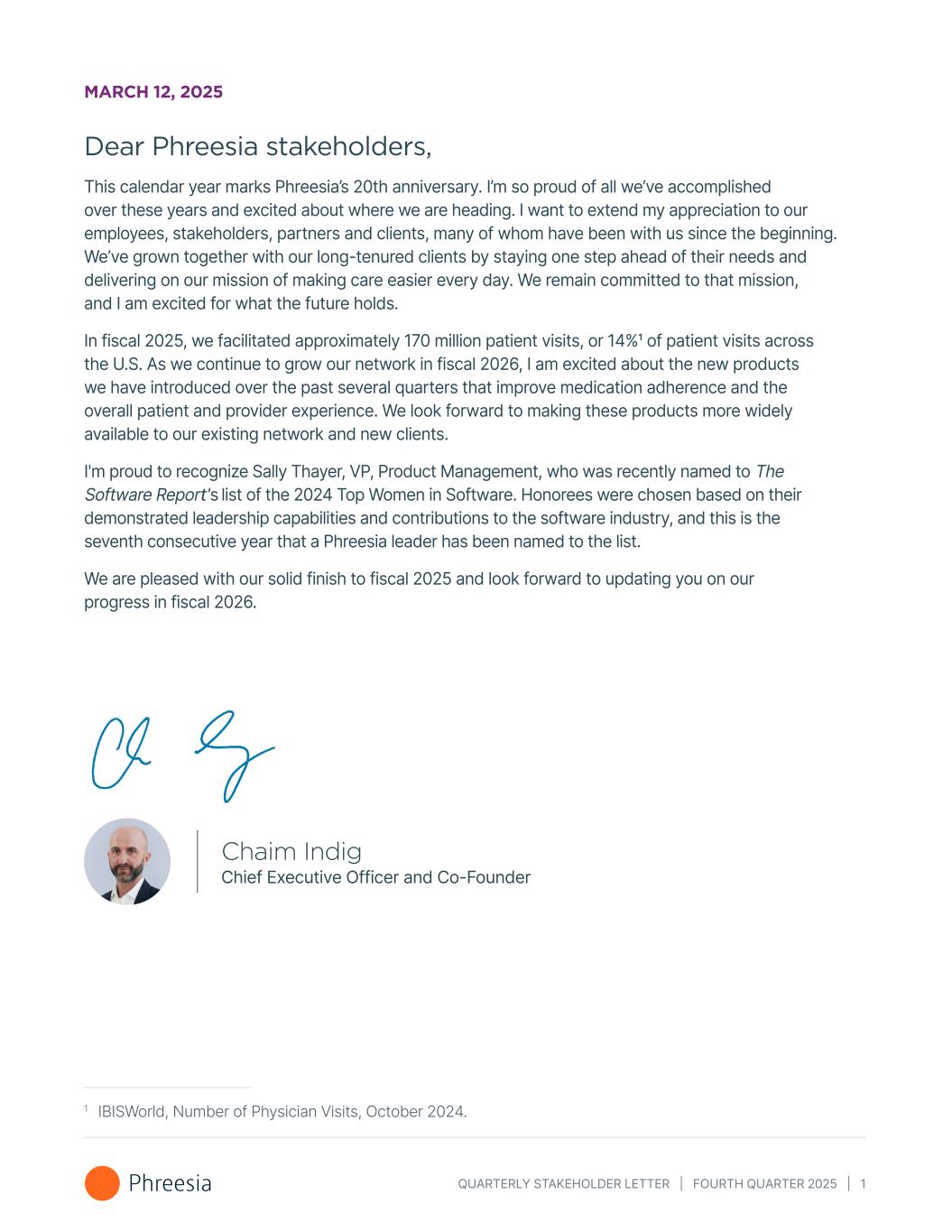
QUARTERLY STAKEHOLDER LETTER | FOURTH QUARTER 2025 | 1 MARCH 12, 2025 Dear Phreesia stakeholders, This calendar year marks Phreesia’s 20th anniversary. I’m so proud of all we’ve accomplished over these years and excited about where we are heading. I want to extend my appreciation to our employees, stakeholders, partners and clients, many of whom have been with us since the beginning. We’ve grown together with our long-tenured clients by staying one step ahead of their needs and delivering on our mission of making care easier every day. We remain committed to that mission, and I am excited for what the future holds. In fiscal 2025, we facilitated approximately 170 million patient visits, or 14%1 of patient visits across the U.S. As we continue to grow our network in fiscal 2026, I am excited about the new products we have introduced over the past several quarters that improve medication adherence and the overall patient and provider experience. We look forward to making these products more widely available to our existing network and new clients. I'm proud to recognize Sally Thayer, VP, Product Management, who was recently named to The Software Report’s list of the 2024 Top Women in Software. Honorees were chosen based on their demonstrated leadership capabilities and contributions to the software industry, and this is the seventh consecutive year that a Phreesia leader has been named to the list. We are pleased with our solid finish to fiscal 2025 and look forward to updating you on our progress in fiscal 2026. Chaim Indig Chief Executive Officer and Co-Founder 1 IBISWorld, Number of Physician Visits, October 2024.
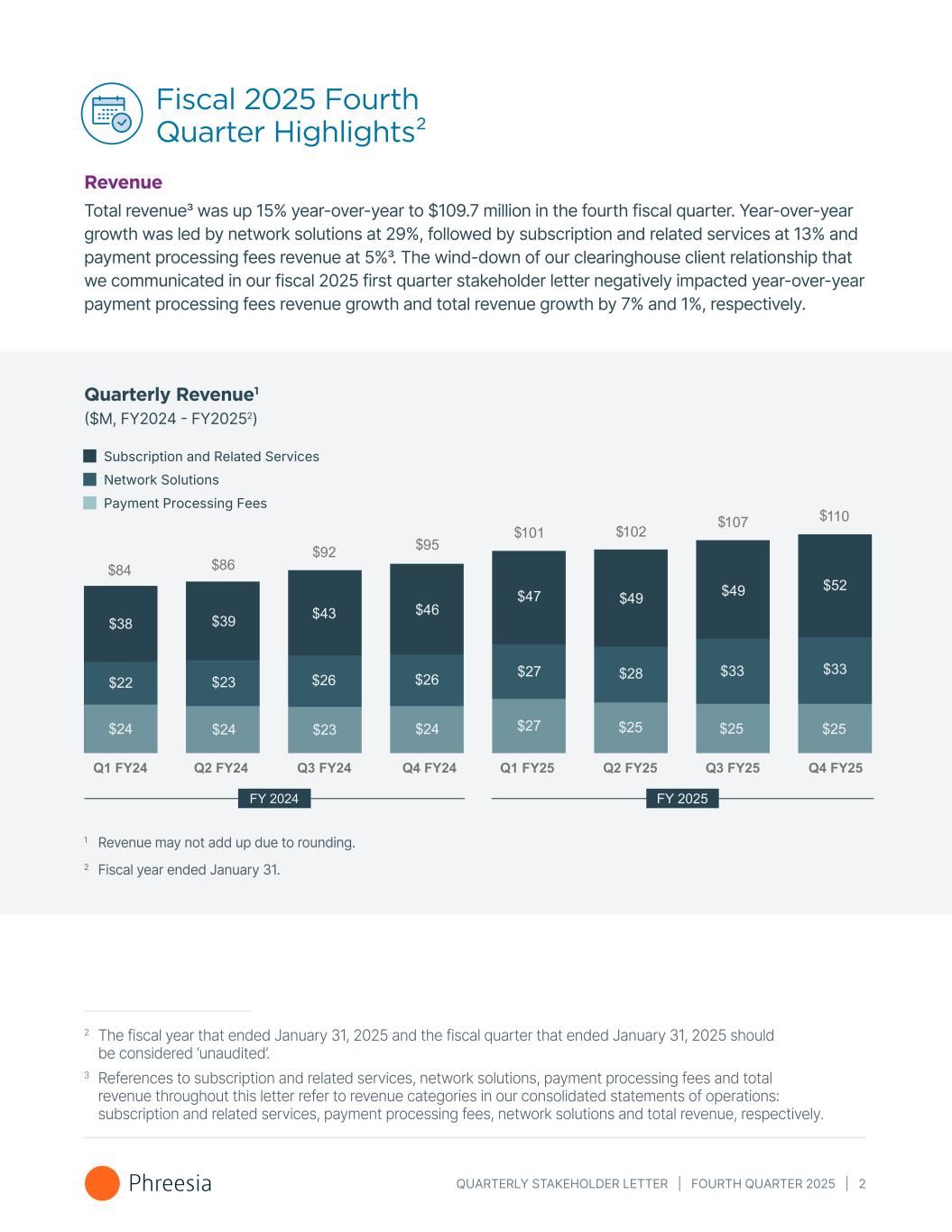
QUARTERLY STAKEHOLDER LETTER | FOURTH QUARTER 2025 | 2 Fiscal 2025 Fourth Quarter Highlights² Revenue Total revenue3 was up 15% year-over-year to $109.7 million in the fourth fiscal quarter. Year-over-year growth was led by network solutions at 29%, followed by subscription and related services at 13% and payment processing fees revenue at 5%3. The wind-down of our clearinghouse client relationship that we communicated in our fiscal 2025 first quarter stakeholder letter negatively impacted year-over-year payment processing fees revenue growth and total revenue growth by 7% and 1%, respectively. 1 Revenue may not add up due to rounding. 2 Fiscal year ended January 31. Subscription and Related Services Payment Processing Fees Network Solutions Quarterly Revenue1 ($M, FY2024 - FY20252) 2 The fiscal year that ended January 31, 2025 and the fiscal quarter that ended January 31, 2025 should be considered ‘unaudited’. 3 References to subscription and related services, network solutions, payment processing fees and total revenue throughout this letter refer to revenue categories in our consolidated statements of operations: subscription and related services, payment processing fees, network solutions and total revenue, respectively.
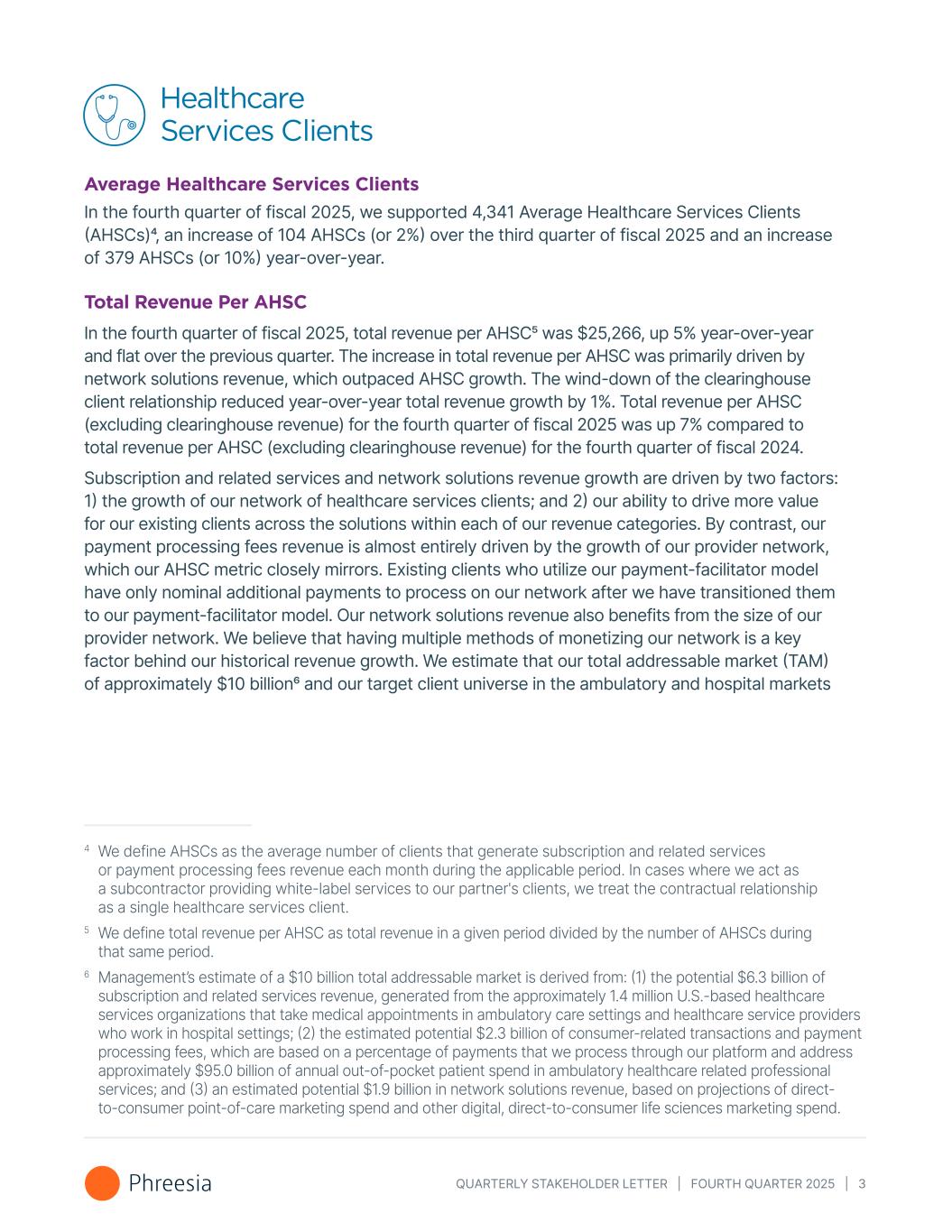
QUARTERLY STAKEHOLDER LETTER | FOURTH QUARTER 2025 | 3 Healthcare Services Clients Average Healthcare Services Clients In the fourth quarter of fiscal 2025, we supported 4,341 Average Healthcare Services Clients (AHSCs)4, an increase of 104 AHSCs (or 2%) over the third quarter of fiscal 2025 and an increase of 379 AHSCs (or 10%) year-over-year. Total Revenue Per AHSC In the fourth quarter of fiscal 2025, total revenue per AHSC5 was $25,266, up 5% year-over-year and flat over the previous quarter. The increase in total revenue per AHSC was primarily driven by network solutions revenue, which outpaced AHSC growth. The wind-down of the clearinghouse client relationship reduced year-over-year total revenue growth by 1%. Total revenue per AHSC (excluding clearinghouse revenue) for the fourth quarter of fiscal 2025 was up 7% compared to total revenue per AHSC (excluding clearinghouse revenue) for the fourth quarter of fiscal 2024. Subscription and related services and network solutions revenue growth are driven by two factors: 1) the growth of our network of healthcare services clients; and 2) our ability to drive more value for our existing clients across the solutions within each of our revenue categories. By contrast, our payment processing fees revenue is almost entirely driven by the growth of our provider network, which our AHSC metric closely mirrors. Existing clients who utilize our payment-facilitator model have only nominal additional payments to process on our network after we have transitioned them to our payment-facilitator model. Our network solutions revenue also benefits from the size of our provider network. We believe that having multiple methods of monetizing our network is a key factor behind our historical revenue growth. We estimate that our total addressable market (TAM) of approximately $10 billion6 and our target client universe in the ambulatory and hospital markets 4 We define AHSCs as the average number of clients that generate subscription and related services or payment processing revenue each month during the applicable period. In cases where we act as a subcontractor providing white-label services to our partner's clients, we treat the contractual relationship as a single healthcare services client. 4 We define AHSCs as the average number of clients that generate subscription and related services or payment processing fees revenue each month during the applicable period. In cases where we act as a subcontractor providing white-label services to our partner's clients, we treat the contractual relationship as a single healthcare services client. 5 We define total revenue per AHSC as total revenue in a given period divided by the number of AHSCs during that same period. 6 Management’s estimate of a $10 billion total addressable market is derived from: (1) the potential $6.3 billion of subscription and related services revenue, generated from the approximately 1.4 million U.S.-based healthcare services organizations that take medical appointments in ambulatory care settings and healthcare service providers who work in hospital settings; (2) the estimated potential $2.3 billion of consumer-related transactions and payment processing fees, which are based on a percentage of payments that we process through our platform and address approximately $95.0 billion of annual out-of-pocket patient spend in ambulatory healthcare related professional services; and (3) an estimated potential $1.9 billion in network solutions revenue, based on projections of direct- to-consumer point-of-care marketing spend and other digital, direct-to-consumer life sciences marketing spend.
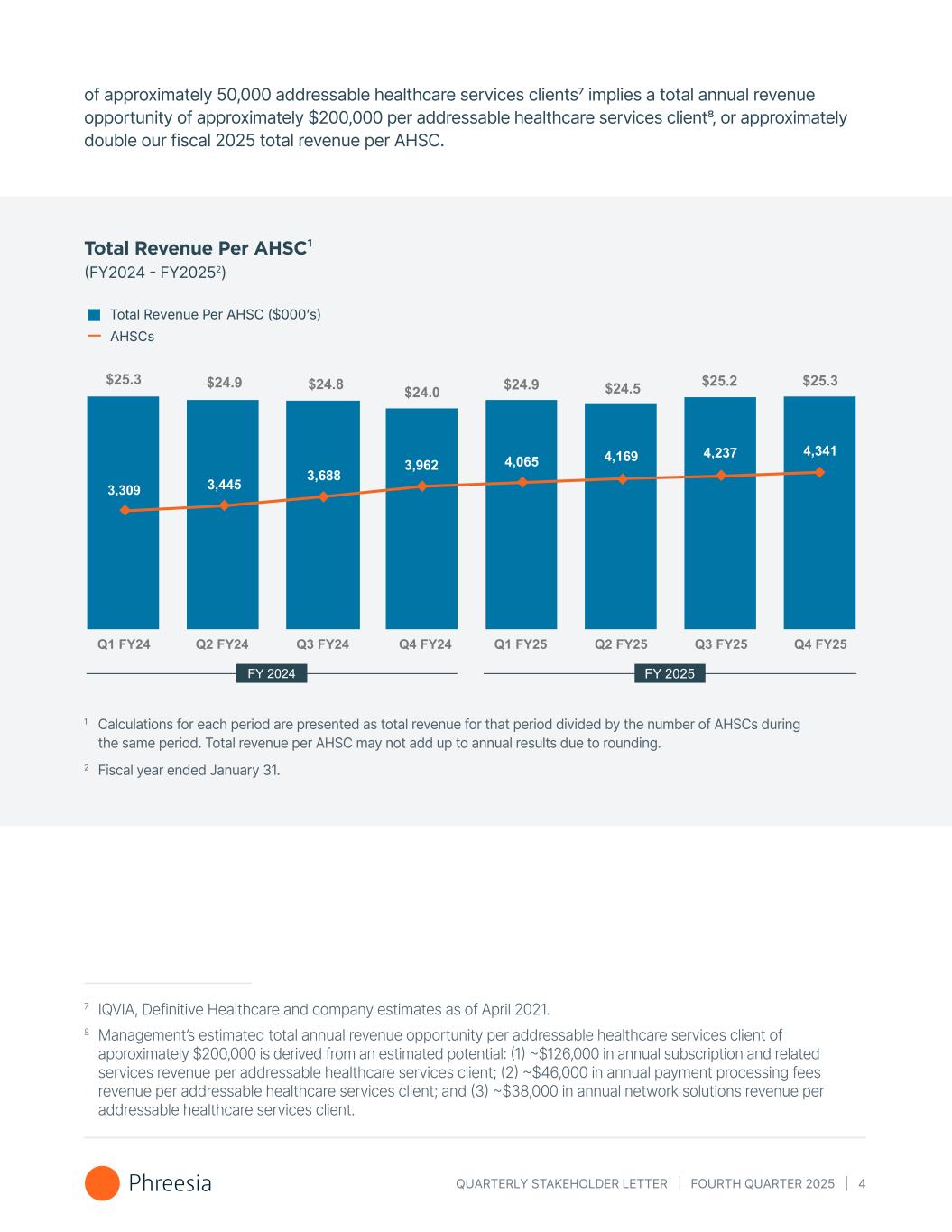
QUARTERLY STAKEHOLDER LETTER | FOURTH QUARTER 2025 | 4 of approximately 50,000 addressable healthcare services clients7 implies a total annual revenue opportunity of approximately $200,000 per addressable healthcare services client8, or approximately double our fiscal 2025 total revenue per AHSC. 7 IQVIA, Definitive Healthcare and company estimates as of April 2021. 8 Management’s estimated total annual revenue opportunity per addressable healthcare services client of approximately $200,000 is derived from an estimated potential: (1) ~$126,000 in annual subscription and related services revenue per addressable healthcare services client; (2) ~$46,000 in annual payment processing fees revenue per addressable healthcare services client; and (3) ~$38,000 in annual network solutions revenue per addressable healthcare services client. 1 Calculations for each period are presented as total revenue for that period divided by the number of AHSCs during the same period. Total revenue per AHSC may not add up to annual results due to rounding. 2 Fiscal year ended January 31. Total Revenue Per AHSC¹ (FY2024 - FY20252) Total Revenue Per AHSC ($000ʼs) AHSCs
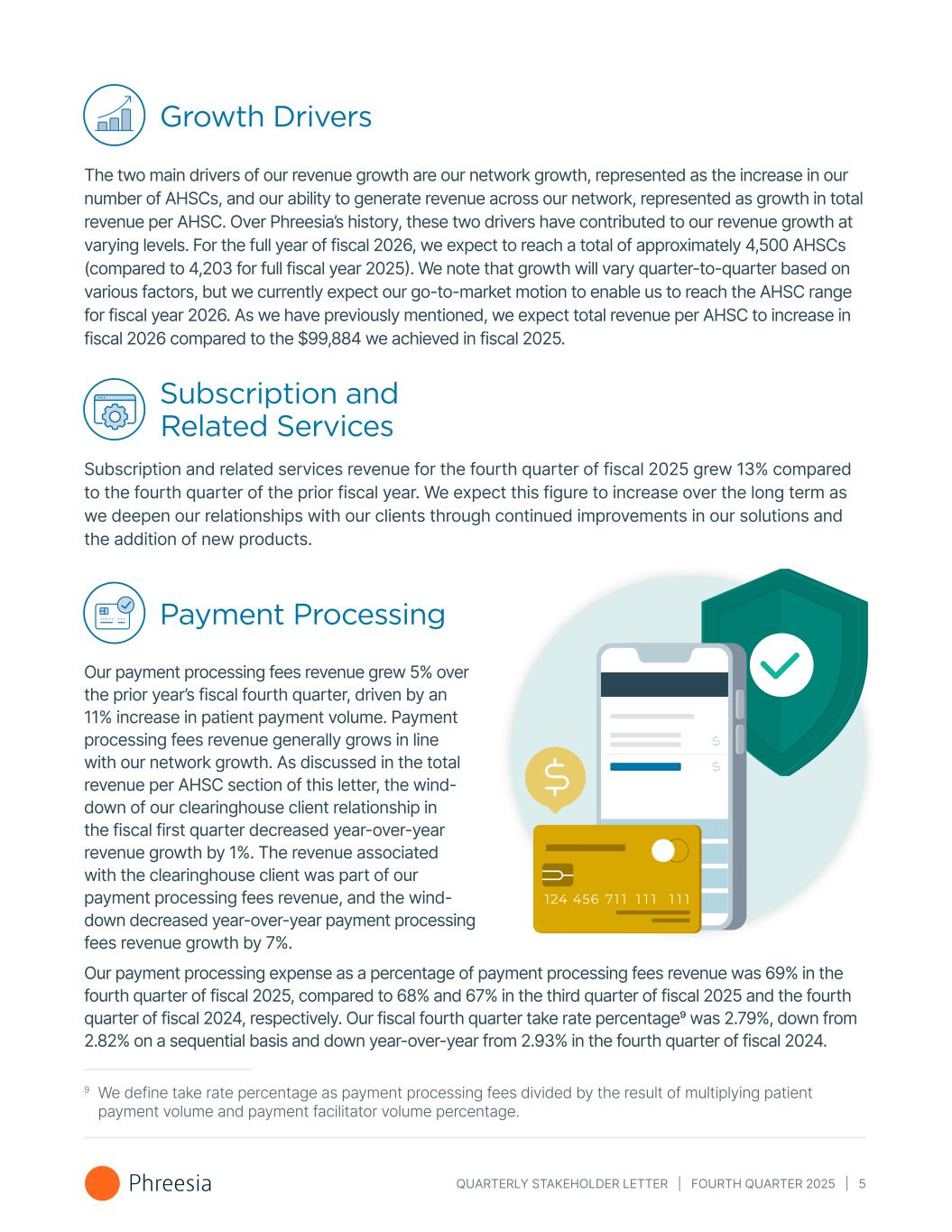
QUARTERLY STAKEHOLDER LETTER | FOURTH QUARTER 2025 | 5 Growth Drivers The two main drivers of our revenue growth are our network growth, represented as the increase in our number of AHSCs, and our ability to generate revenue across our network, represented as growth in total revenue per AHSC. Over Phreesia’s history, these two drivers have contributed to our revenue growth at varying levels. For the full year of fiscal 2026, we expect to reach a total of approximately 4,500 AHSCs (compared to 4,203 for full fiscal year 2025). We note that growth will vary quarter-to-quarter based on various factors, but we currently expect our go-to-market motion to enable us to reach the AHSC range for fiscal year 2026. As we have previously mentioned, we expect total revenue per AHSC to increase in fiscal 2026 compared to the $99,884 we achieved in fiscal 2025. Subscription and Related Services Subscription and related services revenue for the fourth quarter of fiscal 2025 grew 13% compared to the fourth quarter of the prior fiscal year. We expect this figure to increase over the long term as we deepen our relationships with our clients through continued improvements in our solutions and the addition of new products. Payment Processing Our payment processing fees revenue grew 5% over the prior year’s fiscal fourth quarter, driven by an 11% increase in patient payment volume. Payment processing fees revenue generally grows in line with our network growth. As discussed in the total revenue per AHSC section of this letter, the wind- down of our clearinghouse client relationship in the fiscal first quarter decreased year-over-year revenue growth by 1%. The revenue associated with the clearinghouse client was part of our payment processing fees revenue, and the wind- down decreased year-over-year payment processing fees revenue growth by 7%. Our payment processing expense as a percentage of payment processing fees revenue was 69% in the fourth quarter of fiscal 2025, compared to 68% and 67% in the third quarter of fiscal 2025 and the fourth quarter of fiscal 2024, respectively. Our fiscal fourth quarter take rate percentage9 was 2.79%, down from 2.82% on a sequential basis and down year-over-year from 2.93% in the fourth quarter of fiscal 2024. 9 We define take rate percentage as payment processing fees divided by the result of multiplying patient payment volume and payment facilitator volume percentage.
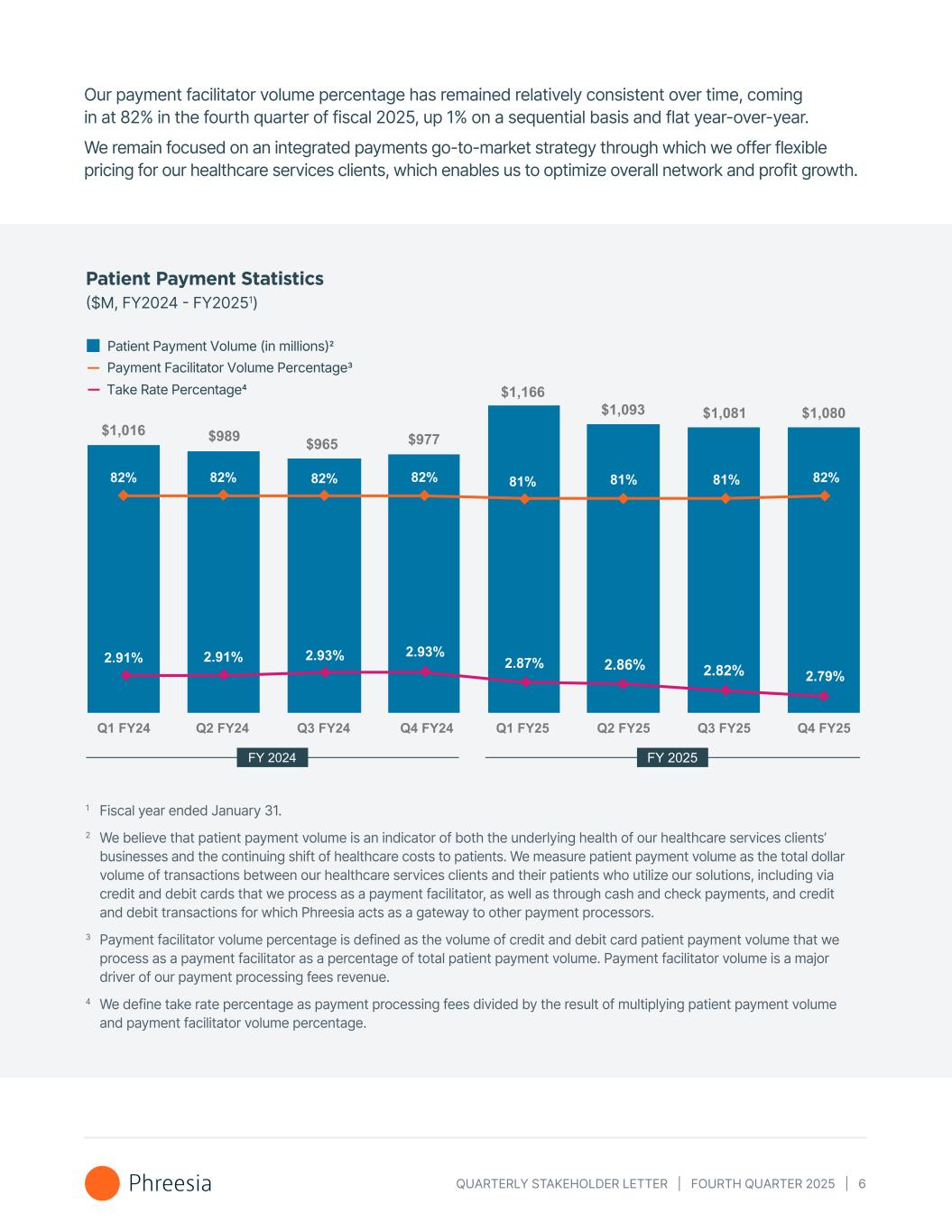
QUARTERLY STAKEHOLDER LETTER | FOURTH QUARTER 2025 | 6 Our payment facilitator volume percentage has remained relatively consistent over time, coming in at 82% in the fourth quarter of fiscal 2025, up 1% on a sequential basis and flat year-over-year. We remain focused on an integrated payments go-to-market strategy through which we offer flexible pricing for our healthcare services clients, which enables us to optimize overall network and profit growth. Patient Payment Statistics ($M, FY2024 - FY20251) 1 Fiscal year ended January 31. 2 We believe that patient payment volume is an indicator of both the underlying health of our healthcare services clients’ businesses and the continuing shift of healthcare costs to patients. We measure patient payment volume as the total dollar volume of transactions between our healthcare services clients and their patients who utilize our solutions, including via credit and debit cards that we process as a payment facilitator, as well as through cash and check payments, and credit and debit transactions for which Phreesia acts as a gateway to other payment processors. 3 Payment facilitator volume percentage is defined as the volume of credit and debit card patient payment volume that we process as a payment facilitator as a percentage of total patient payment volume. Payment facilitator volume is a major driver of our payment processing fees revenue. 4 We define take rate percentage as payment processing fees divided by the result of multiplying patient payment volume and payment facilitator volume percentage. 81% 81% 81% Patient Payment Volume (in millions)2 Take Rate Percentage4 Payment Facilitator Volume Percentage3
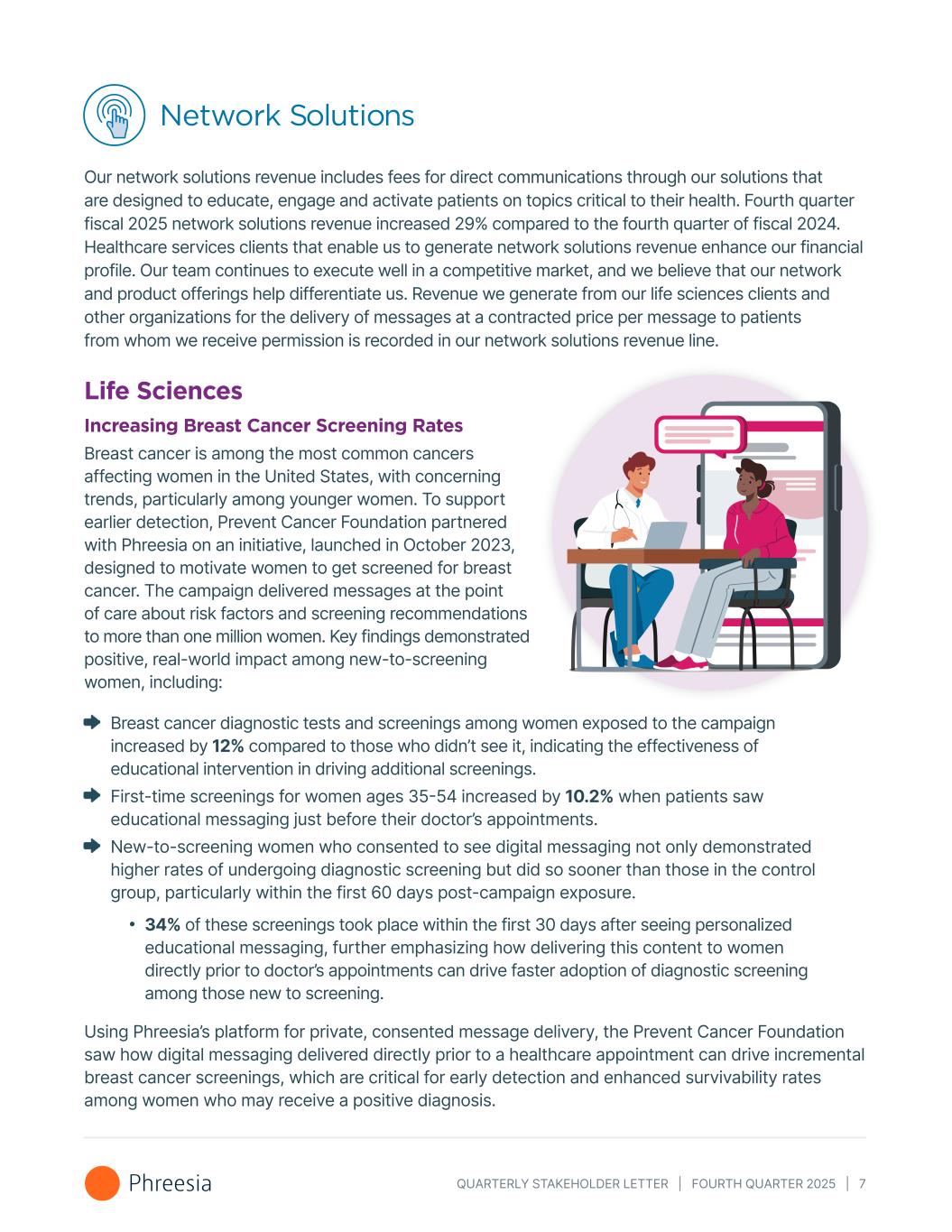
QUARTERLY STAKEHOLDER LETTER | FOURTH QUARTER 2025 | 7 Network Solutions Our network solutions revenue includes fees for direct communications through our solutions that are designed to educate, engage and activate patients on topics critical to their health. Fourth quarter fiscal 2025 network solutions revenue increased 29% compared to the fourth quarter of fiscal 2024. Healthcare services clients that enable us to generate network solutions revenue enhance our financial profile. Our team continues to execute well in a competitive market, and we believe that our network and product offerings help differentiate us. Revenue we generate from our life sciences clients and other organizations for the delivery of messages at a contracted price per message to patients from whom we receive permission is recorded in our network solutions revenue line. Life Sciences Increasing Breast Cancer Screening Rates Breast cancer is among the most common cancers affecting women in the United States, with concerning trends, particularly among younger women. To support earlier detection, Prevent Cancer Foundation partnered with Phreesia on an initiative, launched in October 2023, designed to motivate women to get screened for breast cancer. The campaign delivered messages at the point of care about risk factors and screening recommendations to more than one million women. Key findings demonstrated positive, real-world impact among new-to-screening women, including: Breast cancer diagnostic tests and screenings among women exposed to the campaign increased by 12% compared to those who didn’t see it, indicating the effectiveness of educational intervention in driving additional screenings. First-time screenings for women ages 35-54 increased by 10.2% when patients saw educational messaging just before their doctor’s appointments. New-to-screening women who consented to see digital messaging not only demonstrated higher rates of undergoing diagnostic screening but did so sooner than those in the control group, particularly within the first 60 days post-campaign exposure. 34% of these screenings took place within the first 30 days after seeing personalized educational messaging, further emphasizing how delivering this content to women directly prior to doctor’s appointments can drive faster adoption of diagnostic screening among those new to screening. Using Phreesia’s platform for private, consented message delivery, the Prevent Cancer Foundation saw how digital messaging delivered directly prior to a healthcare appointment can drive incremental breast cancer screenings, which are critical for early detection and enhanced survivability rates among women who may receive a positive diagnosis.
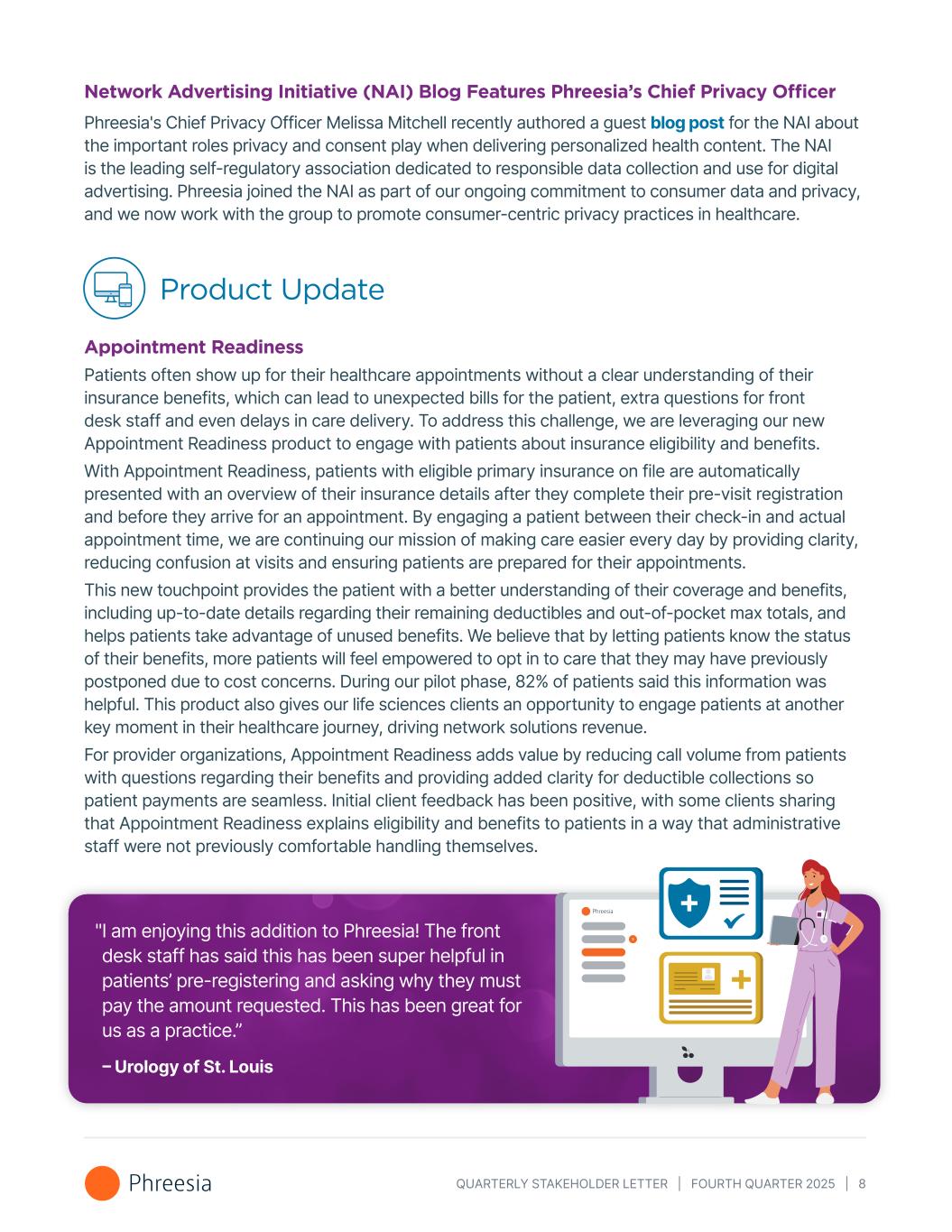
QUARTERLY STAKEHOLDER LETTER | FOURTH QUARTER 2025 | 8 Network Advertising Initiative (NAI) Blog Features Phreesia’s Chief Privacy Officer Phreesia's Chief Privacy Officer Melissa Mitchell recently authored a guest blog post for the NAI about the important roles privacy and consent play when delivering personalized health content. The NAI is the leading self-regulatory association dedicated to responsible data collection and use for digital advertising. Phreesia joined the NAI as part of our ongoing commitment to consumer data and privacy, and we now work with the group to promote consumer-centric privacy practices in healthcare. Product Update Appointment Readiness Patients often show up for their healthcare appointments without a clear understanding of their insurance benefits, which can lead to unexpected bills for the patient, extra questions for front desk staff and even delays in care delivery. To address this challenge, we are leveraging our new Appointment Readiness product to engage with patients about insurance eligibility and benefits. With Appointment Readiness, patients with eligible primary insurance on file are automatically presented with an overview of their insurance details after they complete their pre-visit registration and before they arrive for an appointment. By engaging a patient between their check-in and actual appointment time, we are continuing our mission of making care easier every day by providing clarity, reducing confusion at visits and ensuring patients are prepared for their appointments. This new touchpoint provides the patient with a better understanding of their coverage and benefits, including up-to-date details regarding their remaining deductibles and out-of-pocket max totals, and helps patients take advantage of unused benefits. We believe that by letting patients know the status of their benefits, more patients will feel empowered to opt in to care that they may have previously postponed due to cost concerns. During our pilot phase, 82% of patients said this information was helpful. This product also gives our life sciences clients an opportunity to engage patients at another key moment in their healthcare journey, driving network solutions revenue. For provider organizations, Appointment Readiness adds value by reducing call volume from patients with questions regarding their benefits and providing added clarity for deductible collections so patient payments are seamless. Initial client feedback has been positive, with some clients sharing that Appointment Readiness explains eligibility and benefits to patients in a way that administrative staff were not previously comfortable handling themselves. " I am enjoying this addition to Phreesia! The front desk staff has said this has been super helpful in patients’ pre-registering and asking why they must pay the amount requested. This has been great for us as a practice.” – Urology of St. Louis
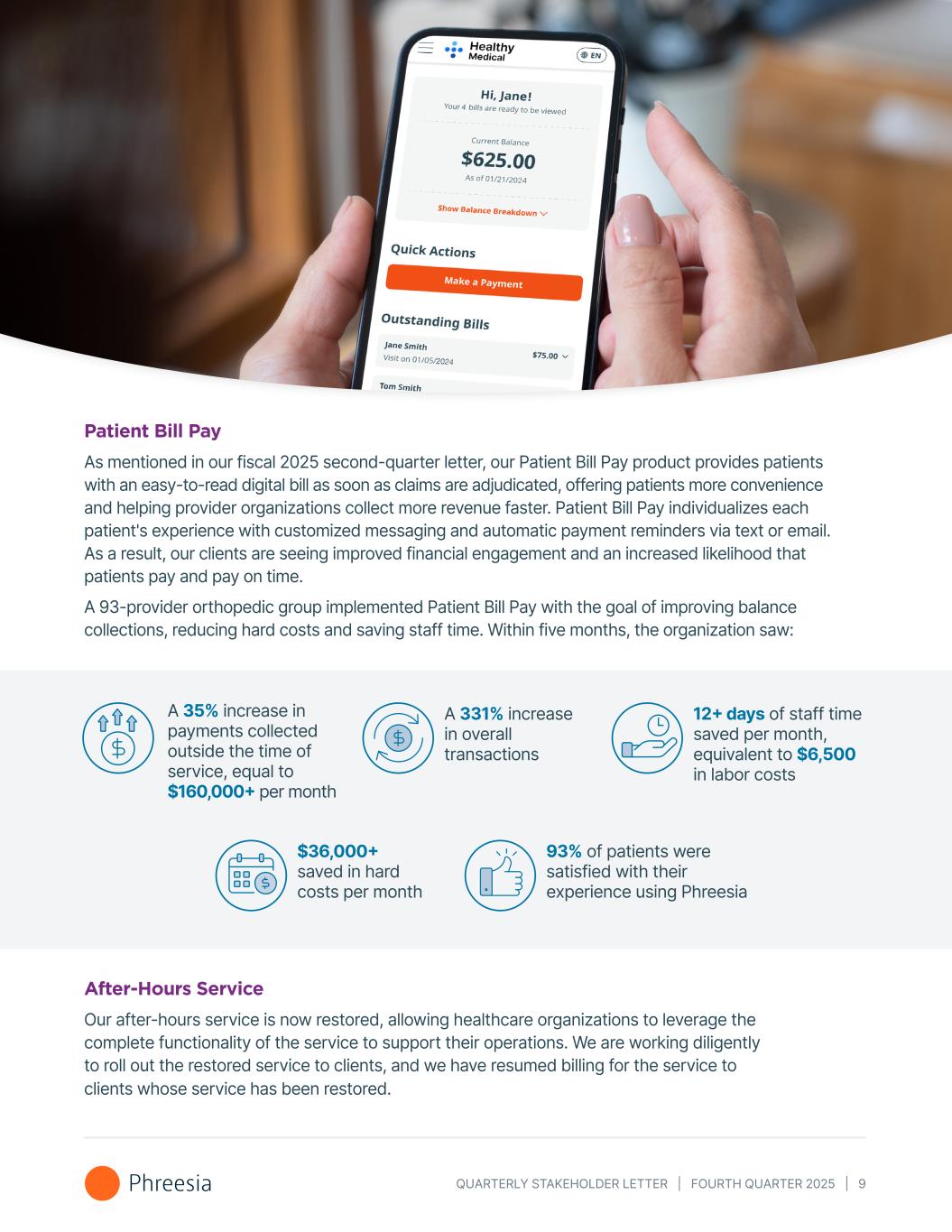
QUARTERLY STAKEHOLDER LETTER | FOURTH QUARTER 2025 | 9 Patient Bill Pay As mentioned in our fiscal 2025 second-quarter letter, our Patient Bill Pay product provides patients with an easy-to-read digital bill as soon as claims are adjudicated, offering patients more convenience and helping provider organizations collect more revenue faster. Patient Bill Pay individualizes each patient's experience with customized messaging and automatic payment reminders via text or email. As a result, our clients are seeing improved financial engagement and an increased likelihood that patients pay and pay on time. A 93-provider orthopedic group implemented Patient Bill Pay with the goal of improving balance collections, reducing hard costs and saving staff time. Within five months, the organization saw: After-Hours Service Our after-hours service is now restored, allowing healthcare organizations to leverage the complete functionality of the service to support their operations. We are working diligently to roll out the restored service to clients, and we have resumed billing for the service to clients whose service has been restored. A 35% increase in payments collected outside the time of service, equal to $160,000+ per month A 331% increase in overall transactions 12+ days of staff time saved per month, equivalent to $6,500 in labor costs $36,000+ saved in hard costs per month 93% of patients were satisfied with their experience using Phreesia
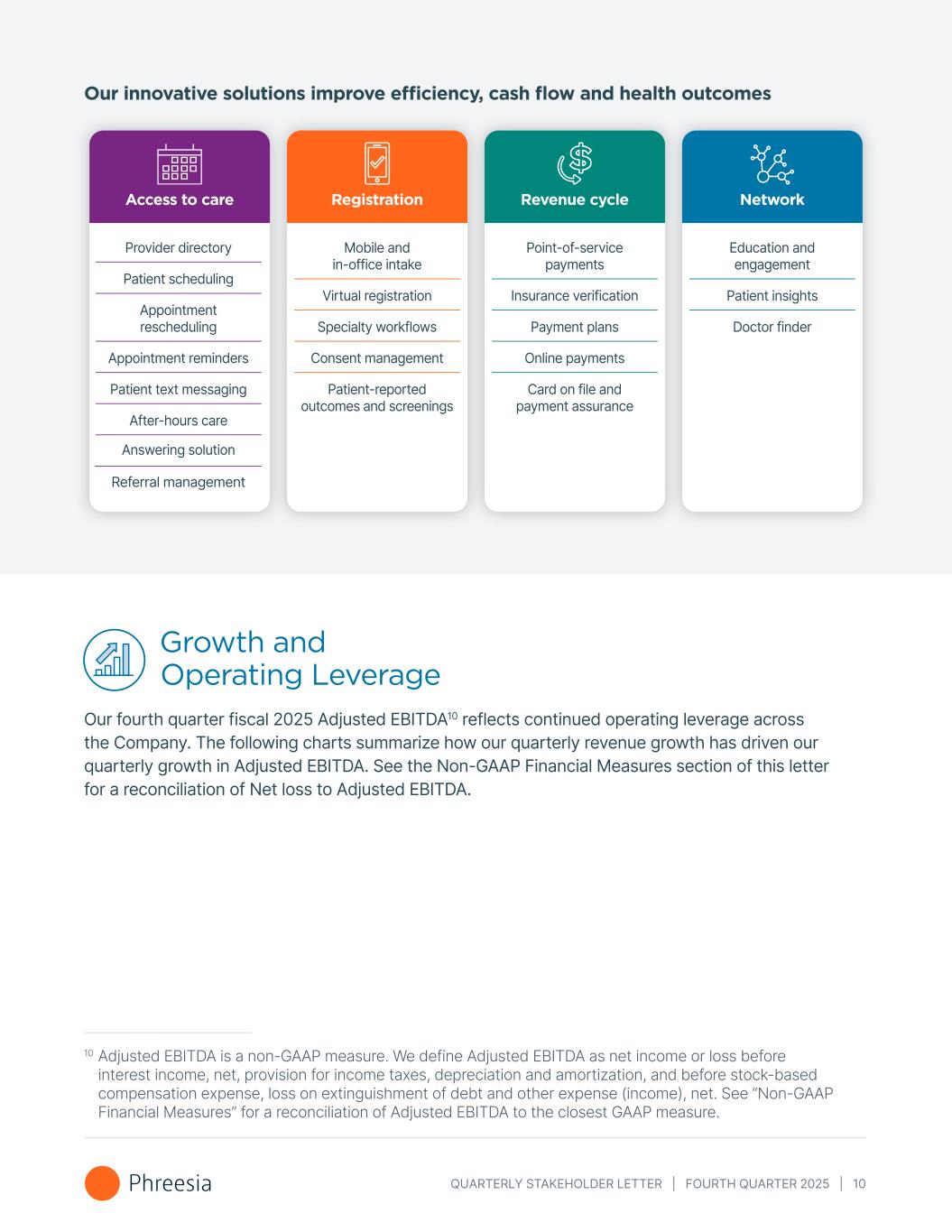
QUARTERLY STAKEHOLDER LETTER | FOURTH QUARTER 2025 | 10 Our innovative solutions improve efficiency, cash flow and health outcomes Access to care Registration Revenue cycle Network Provider directory Patient scheduling Appointment rescheduling Appointment reminders Patient text messaging After-hours care Answering solution Referral management Mobile and in-office intake Virtual registration Specialty workflows Consent management Patient-reported outcomes and screenings Point-of-service payments Insurance verification Payment plans Online payments Card on file and payment assurance Education and engagement Patient insights Doctor finder Growth and Operating Leverage Our fourth quarter fiscal 2025 Adjusted EBITDA10 reflects continued operating leverage across the Company. The following charts summarize how our quarterly revenue growth has driven our quarterly growth in Adjusted EBITDA. See the Non-GAAP Financial Measures section of this letter for a reconciliation of Net loss to Adjusted EBITDA. 10 Adjusted EBITDA is a non-GAAP measure. We define Adjusted EBITDA as net income or loss before interest income, net, provision for income taxes, depreciation and amortization, and before stock-based compensation expense, loss on extinguishment of debt and other expense (income), net. See “Non-GAAP Financial Measures” for a reconciliation of Adjusted EBITDA to the closest GAAP measure.
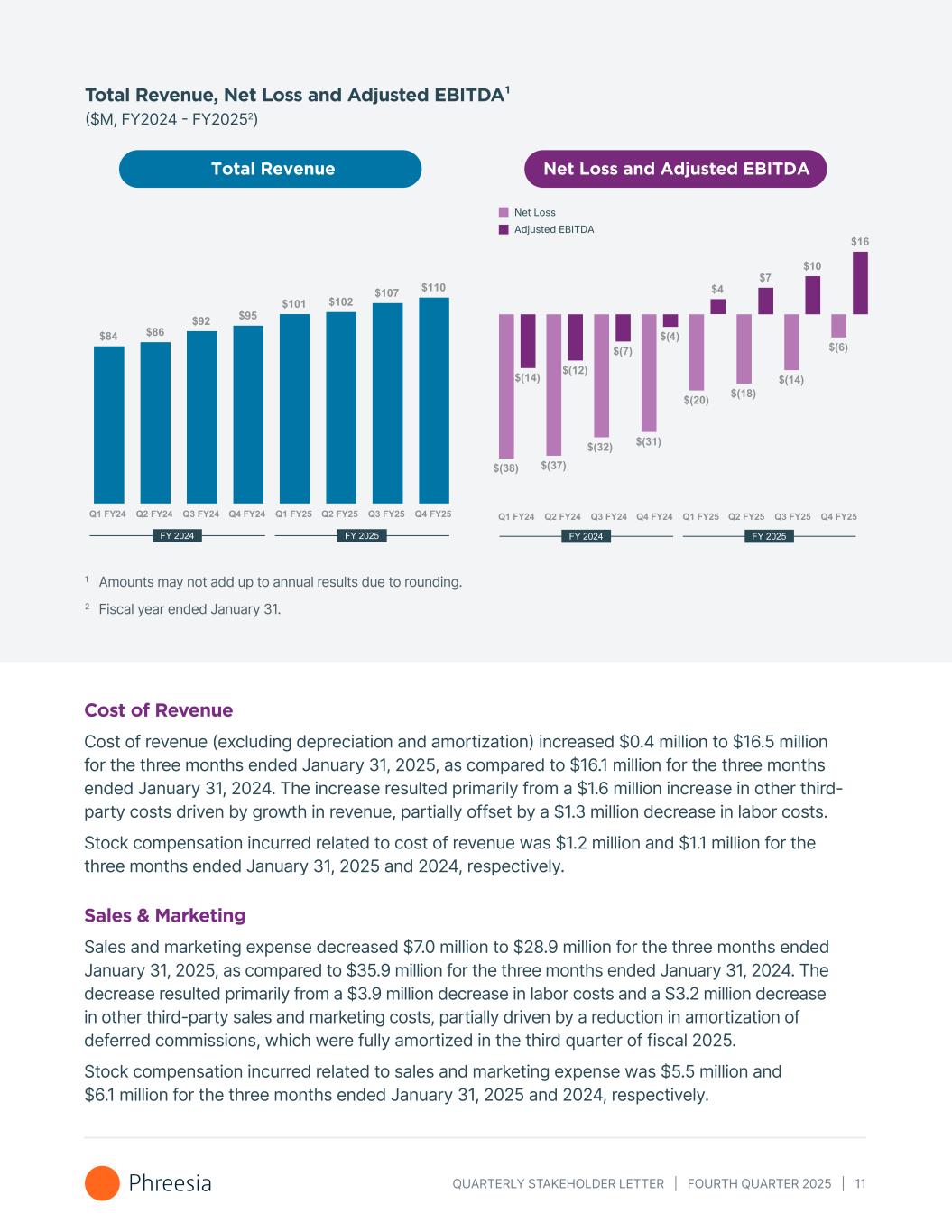
QUARTERLY STAKEHOLDER LETTER | FOURTH QUARTER 2025 | 11 Total Revenue, Net Loss and Adjusted EBITDA¹ ($M, FY2024 - FY20252) 1 Amounts may not add up to annual results due to rounding. 2 Fiscal year ended January 31. Net Loss and Adjusted EBITDATotal Revenue Adjusted EBITDA Net Loss Cost of Revenue Cost of revenue (excluding depreciation and amortization) increased $0.4 million to $16.5 million for the three months ended January 31, 2025, as compared to $16.1 million for the three months ended January 31, 2024. The increase resulted primarily from a $1.6 million increase in other third- party costs driven by growth in revenue, partially offset by a $1.3 million decrease in labor costs. Stock compensation incurred related to cost of revenue was $1.2 million and $1.1 million for the three months ended January 31, 2025 and 2024, respectively. Sales & Marketing Sales and marketing expense decreased $7.0 million to $28.9 million for the three months ended January 31, 2025, as compared to $35.9 million for the three months ended January 31, 2024. The decrease resulted primarily from a $3.9 million decrease in labor costs and a $3.2 million decrease in other third-party sales and marketing costs, partially driven by a reduction in amortization of deferred commissions, which were fully amortized in the third quarter of fiscal 2025. Stock compensation incurred related to sales and marketing expense was $5.5 million and $6.1 million for the three months ended January 31, 2025 and 2024, respectively.
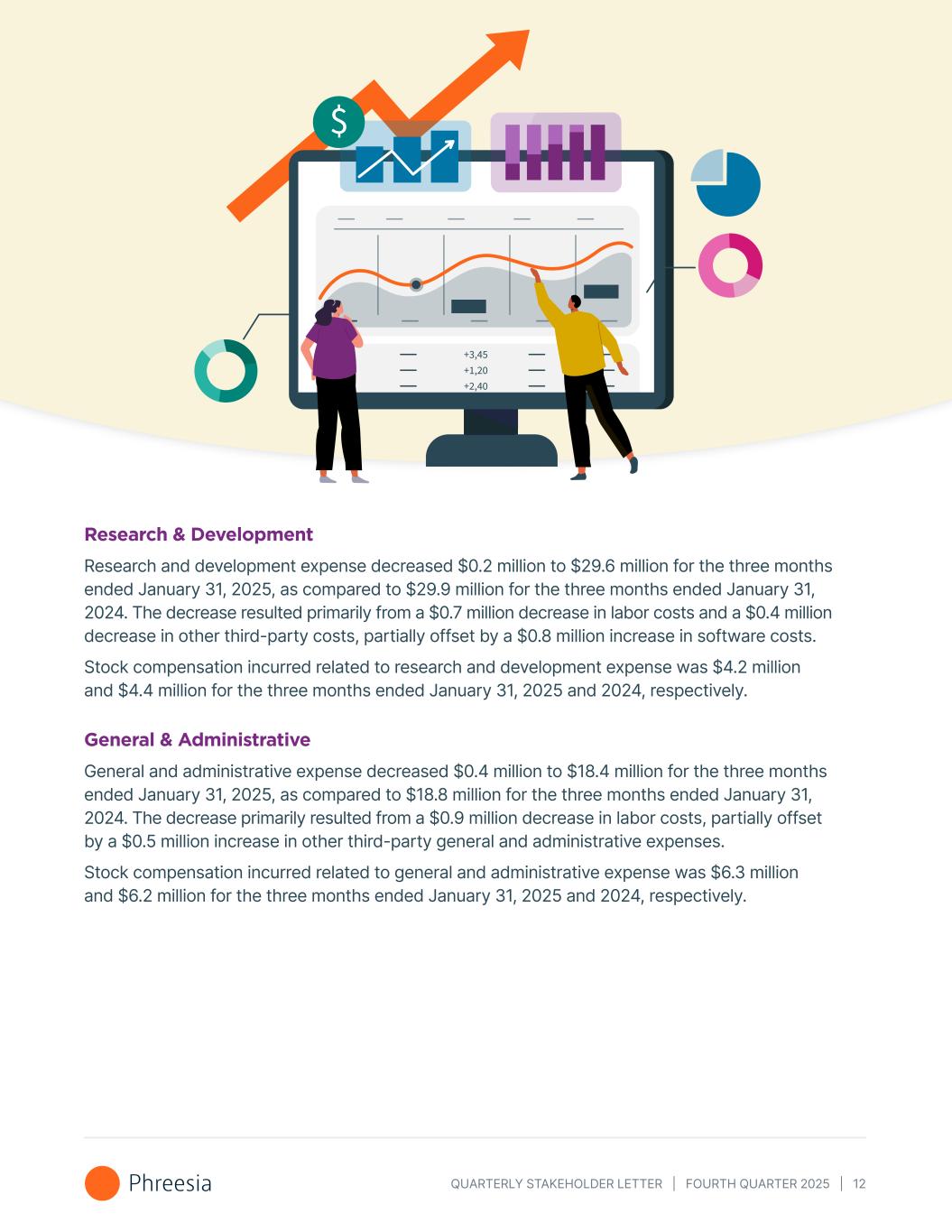
QUARTERLY STAKEHOLDER LETTER | FOURTH QUARTER 2025 | 12 Research & Development Research and development expense decreased $0.2 million to $29.6 million for the three months ended January 31, 2025, as compared to $29.9 million for the three months ended January 31, 2024. The decrease resulted primarily from a $0.7 million decrease in labor costs and a $0.4 million decrease in other third-party costs, partially offset by a $0.8 million increase in software costs. Stock compensation incurred related to research and development expense was $4.2 million and $4.4 million for the three months ended January 31, 2025 and 2024, respectively. General & Administrative General and administrative expense decreased $0.4 million to $18.4 million for the three months ended January 31, 2025, as compared to $18.8 million for the three months ended January 31, 2024. The decrease primarily resulted from a $0.9 million decrease in labor costs, partially offset by a $0.5 million increase in other third-party general and administrative expenses. Stock compensation incurred related to general and administrative expense was $6.3 million and $6.2 million for the three months ended January 31, 2025 and 2024, respectively.
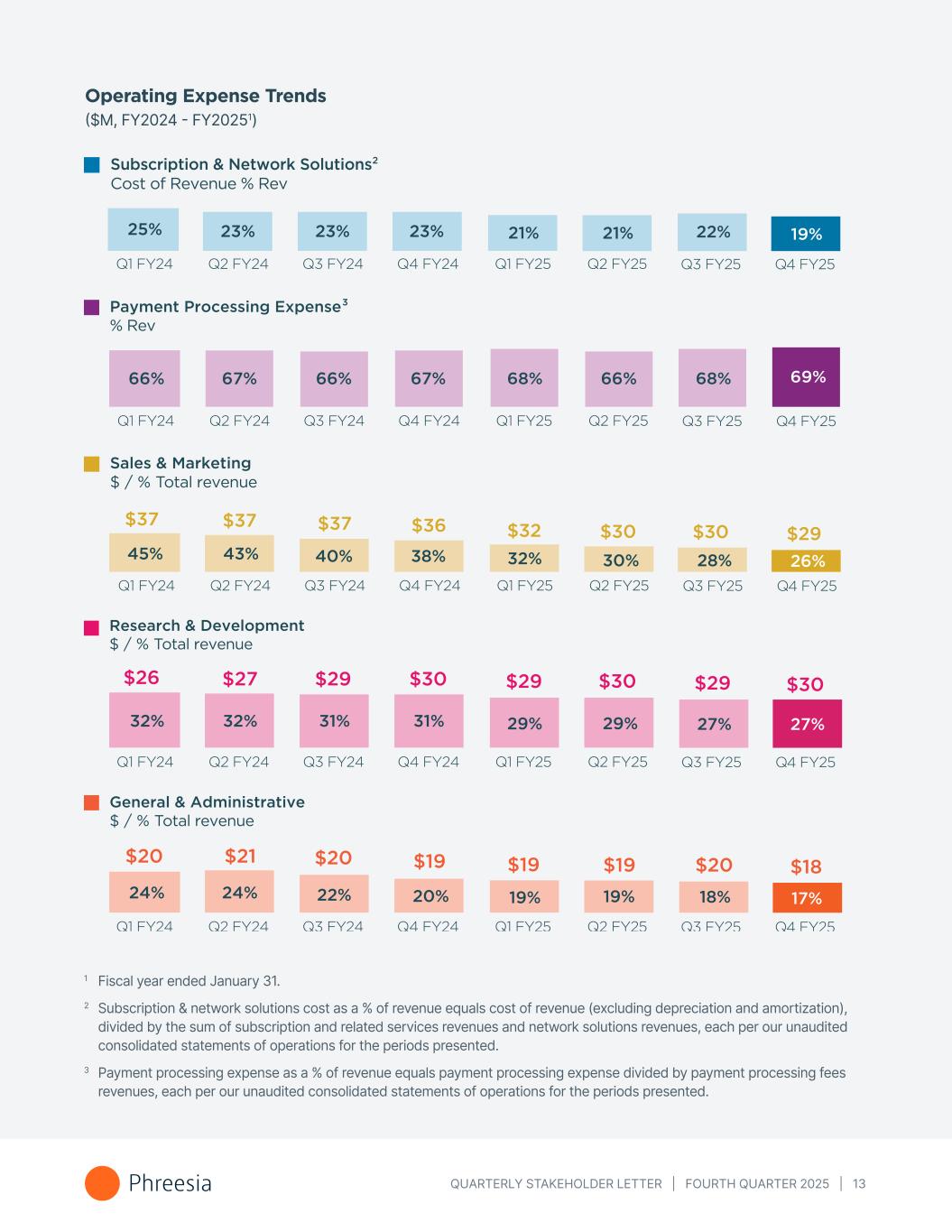
QUARTERLY STAKEHOLDER LETTER | FOURTH QUARTER 2025 | 13 12 Adjusted EBITDA is a non-GAAP measure. We define Adjusted EBITDA as net income or loss before interest income, net, provision for income taxes, depreciation and amortization, and before stock-based compensation expense, loss on extinguishment of debt and other expense (income), net. See “Non-GAAP Financial Measures” for a reconciliation of Adjusted EBITDA to the closest GAAP measure. Operating Expense Trends ($M, FY2024 - FY20251) 1 Fiscal year ended January 31. 2 Subscription & network solutions cost as a % of revenue equals cost of revenue (excluding depreciation and amortization), divided by the sum of subscription and related services revenues and network solutions revenues, each per our unaudited consolidated statements of operations for the periods presented. 3 Payment processing expense as a % of revenue equals payment processing expense divided by payment processing fees revenues, each per our unaudited consolidated statements of operations for the periods presented. Sales & Marketing $ / % Total revenue 45% $37 43% $37 40% $37 38% $36 32% $32 Research & Development $ / % Total revenue 32% $26 32% $27 31% $29 31% $30 29% $29 General & Administrative $ / % Total revenue 24% $20 24% $21 22% $20 20% $19 19% $19 Payment Processing Expense % Rev 66% 67% 66% 67% 68% Subscription & Network Solutions Cost of Revenue % Rev 25% Q1 FY24 Q2 FY24 Q3 FY24 Q4 FY24 23% Q1 FY25 23% Q2 FY25 23% 21% 21% 66% 30% $30 29% $30 19% $19 22% Q3 FY25 68% 28% $30 27% $29 18% $20 19% Q FY25 69% 26% $29 27% $30 17% $18 4 2 3 Q1 FY24 Q2 FY24 Q3 FY24 Q4 FY24 Q1 FY25 Q2 FY25 Q3 FY25 Q FY254 Q1 FY24 Q2 FY24 Q3 FY24 Q4 FY24 Q1 FY25 Q2 FY25 Q3 FY25 Q FY254 Q1 FY24 Q2 FY24 Q3 FY24 Q4 FY24 Q1 FY25 Q2 FY25 Q3 FY25 Q FY254 Q1 FY24 Q2 FY24 Q3 FY24 Q4 FY24 Q1 FY25 Q2 FY25 Q3 FY25 Q FY254
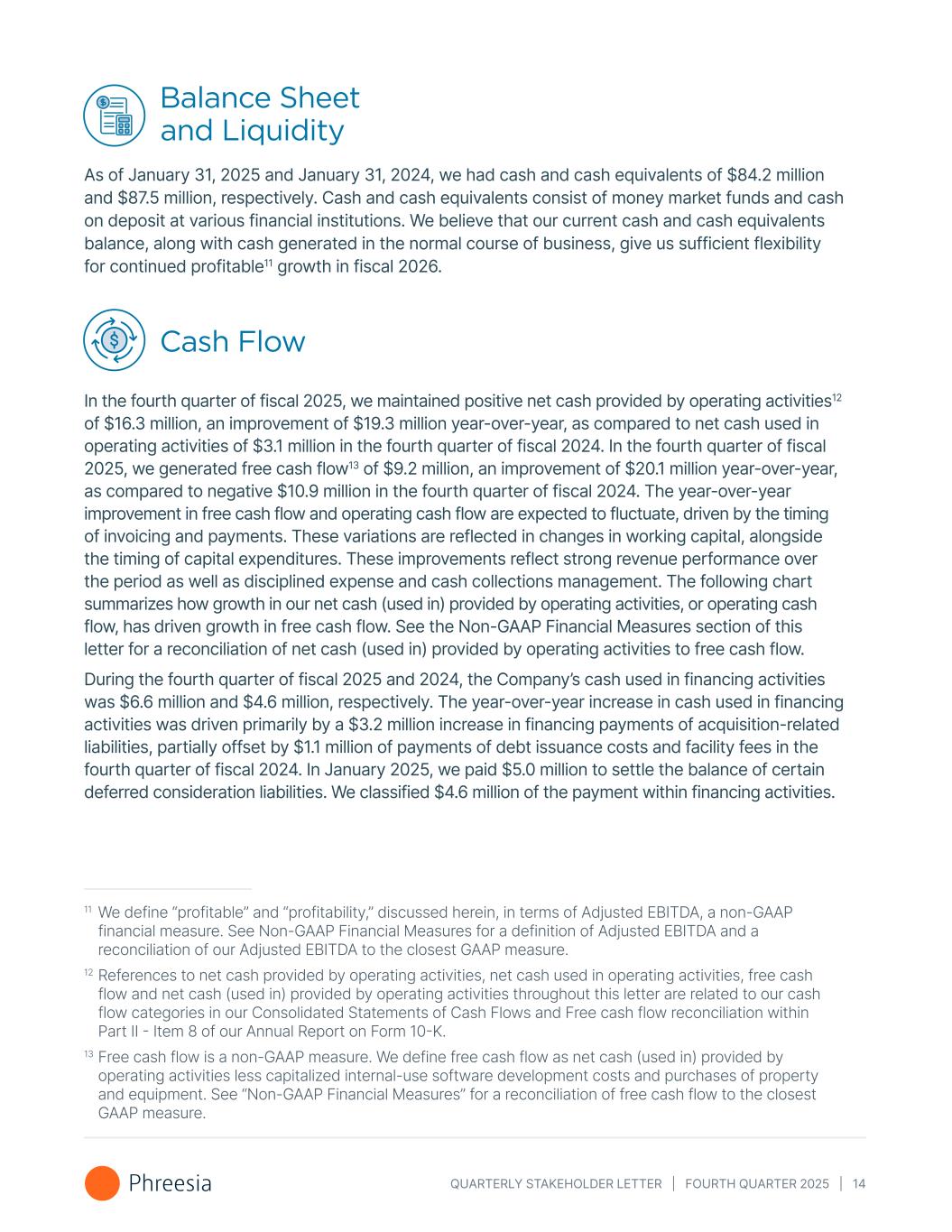
QUARTERLY STAKEHOLDER LETTER | FOURTH QUARTER 2025 | 14 Balance Sheet and Liquidity As of January 31, 2025 and January 31, 2024, we had cash and cash equivalents of $84.2 million and $87.5 million, respectively. Cash and cash equivalents consist of money market funds and cash on deposit at various financial institutions. We believe that our current cash and cash equivalents balance, along with cash generated in the normal course of business, give us sufficient flexibility for continued profitable11 growth in fiscal 2026. Cash Flow In the fourth quarter of fiscal 2025, we maintained positive net cash provided by operating activities12 of $16.3 million, an improvement of $19.3 million year-over-year, as compared to net cash used in operating activities of $3.1 million in the fourth quarter of fiscal 2024. In the fourth quarter of fiscal 2025, we generated free cash flow13 of $9.2 million, an improvement of $20.1 million year-over-year, as compared to negative $10.9 million in the fourth quarter of fiscal 2024. The year-over-year improvement in free cash flow and operating cash flow are expected to fluctuate, driven by the timing of invoicing and payments. These variations are reflected in changes in working capital, alongside the timing of capital expenditures. These improvements reflect strong revenue performance over the period as well as disciplined expense and cash collections management. The following chart summarizes how growth in our net cash (used in) provided by operating activities, or operating cash flow, has driven growth in free cash flow. See the Non-GAAP Financial Measures section of this letter for a reconciliation of net cash (used in) provided by operating activities to free cash flow. During the fourth quarter of fiscal 2025 and 2024, the Company’s cash used in financing activities was $6.6 million and $4.6 million, respectively. The year-over-year increase in cash used in financing activities was driven primarily by a $3.2 million increase in financing payments of acquisition-related liabilities, partially offset by $1.1 million of payments of debt issuance costs and facility fees in the fourth quarter of fiscal 2024. In January 2025, we paid $5.0 million to settle the balance of certain deferred consideration liabilities. We classified $4.6 million of the payment within financing activities. 11 We define “profitable” and “profitability,” discussed herein, in terms of Adjusted EBITDA, a non-GAAP financial measure. See Non-GAAP Financial Measures for a definition of Adjusted EBITDA and a reconciliation of our Adjusted EBITDA to the closest GAAP measure. 12 References to net cash provided by operating activities, net cash used in operating activities, free cash flow and net cash (used in) provided by operating activities throughout this letter are related to our cash flow categories in our Consolidated Statements of Cash Flows and Free cash flow reconciliation within Part II - Item 8 of our Annual Report on Form 10-K. 13 Free cash flow is a non-GAAP measure. We define free cash flow as net cash (used in) provided by operating activities less capitalized internal-use software development costs and purchases of property and equipment. See “Non-GAAP Financial Measures” for a reconciliation of free cash flow to the closest GAAP measure.
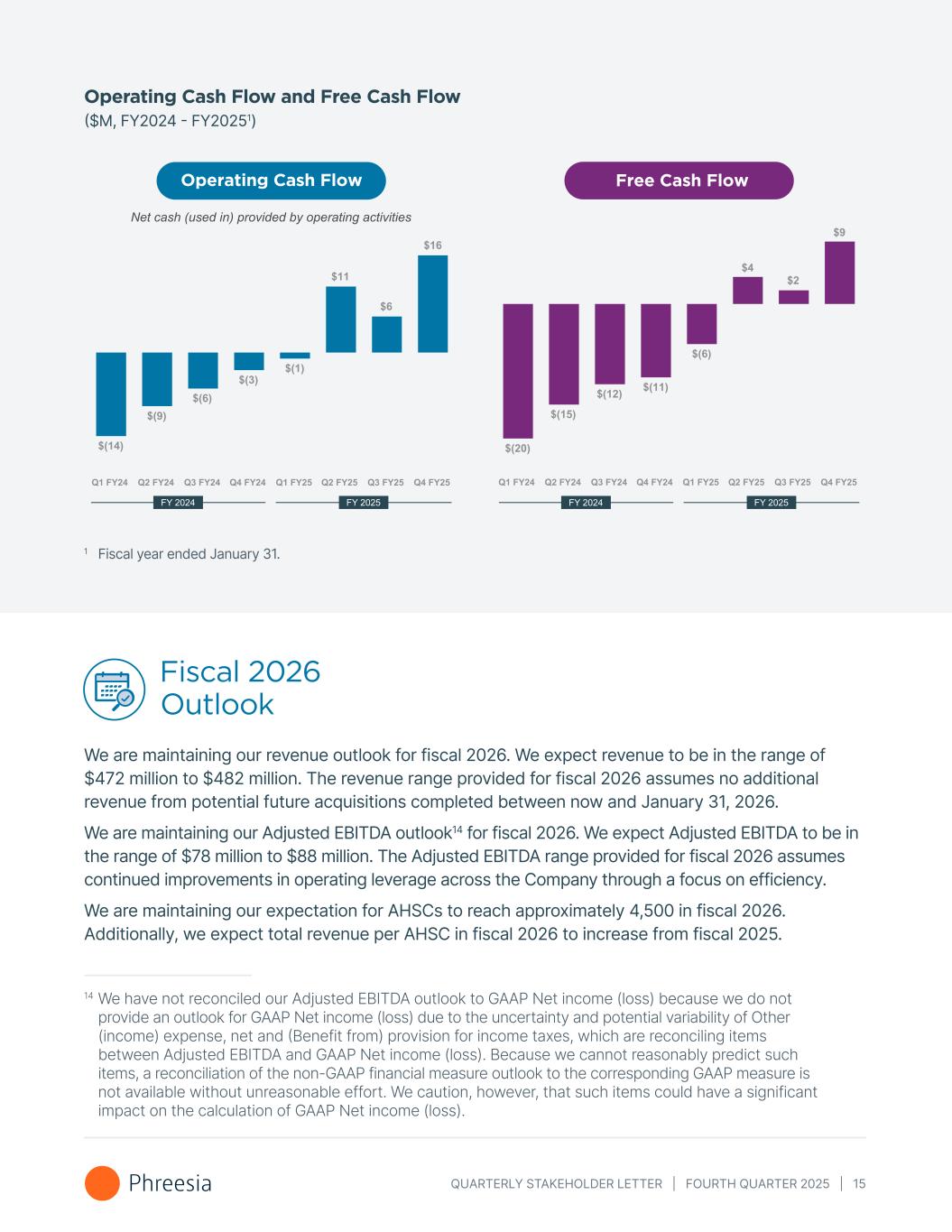
QUARTERLY STAKEHOLDER LETTER | FOURTH QUARTER 2025 | 15 Operating Cash Flow and Free Cash Flow ($M, FY2024 - FY20251) 1 Fiscal year ended January 31. Fiscal 2026 Outlook We are maintaining our revenue outlook for fiscal 2026. We expect revenue to be in the range of $472 million to $482 million. The revenue range provided for fiscal 2026 assumes no additional revenue from potential future acquisitions completed between now and January 31, 2026. We are maintaining our Adjusted EBITDA outlook14 for fiscal 2026. We expect Adjusted EBITDA to be in the range of $78 million to $88 million. The Adjusted EBITDA range provided for fiscal 2026 assumes continued improvements in operating leverage across the Company through a focus on efficiency. We are maintaining our expectation for AHSCs to reach approximately 4,500 in fiscal 2026. Additionally, we expect total revenue per AHSC in fiscal 2026 to increase from fiscal 2025. Operating Cash Flow Free Cash Flow 14 We have not reconciled our Adjusted EBITDA outlook to GAAP Net income (loss) because we do not provide an outlook for GAAP Net income (loss) due to the uncertainty and potential variability of Other (income) expense, net and (Benefit from) provision for income taxes, which are reconciling items between Adjusted EBITDA and GAAP Net income (loss). Because we cannot reasonably predict such items, a reconciliation of the non-GAAP financial measure outlook to the corresponding GAAP measure is not available without unreasonable effort. We caution, however, that such items could have a significant impact on the calculation of GAAP Net income (loss).
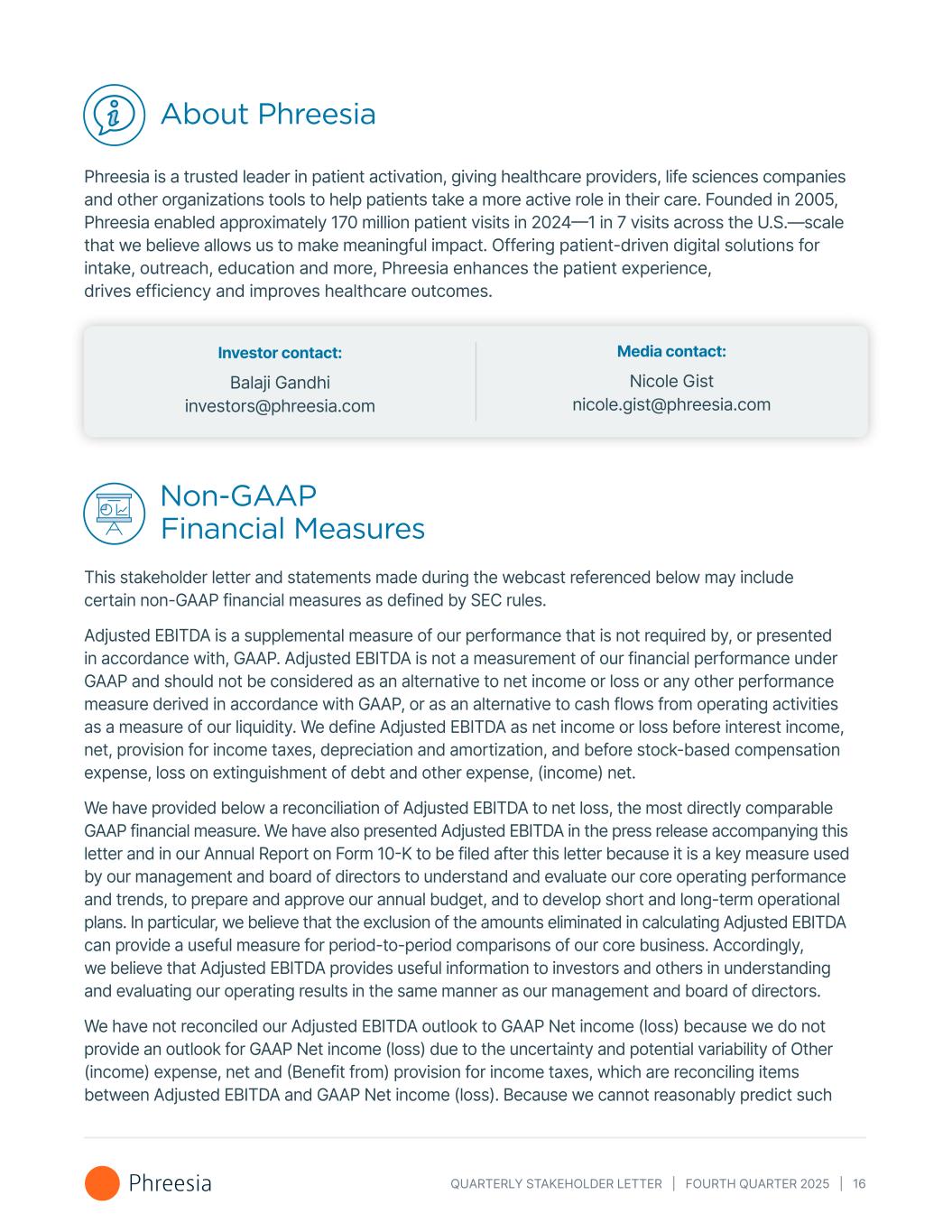
QUARTERLY STAKEHOLDER LETTER | FOURTH QUARTER 2025 | 16 About Phreesia Phreesia is a trusted leader in patient activation, giving healthcare providers, life sciences companies and other organizations tools to help patients take a more active role in their care. Founded in 2005, Phreesia enabled approximately 170 million patient visits in 2024—1 in 7 visits across the U.S.—scale that we believe allows us to make meaningful impact. Offering patient-driven digital solutions for intake, outreach, education and more, Phreesia enhances the patient experience, drives efficiency and improves healthcare outcomes. Media contact: Nicole Gist [email protected] Investor contact: Balaji Gandhi [email protected] Non-GAAP Financial Measures This stakeholder letter and statements made during the webcast referenced below may include certain non-GAAP financial measures as defined by SEC rules. Adjusted EBITDA is a supplemental measure of our performance that is not required by, or presented in accordance with, GAAP. Adjusted EBITDA is not a measurement of our financial performance under GAAP and should not be considered as an alternative to net income or loss or any other performance measure derived in accordance with GAAP, or as an alternative to cash flows from operating activities as a measure of our liquidity. We define Adjusted EBITDA as net income or loss before interest income, net, provision for income taxes, depreciation and amortization, and before stock-based compensation expense, loss on extinguishment of debt and other expense, (income) net. We have provided below a reconciliation of Adjusted EBITDA to net loss, the most directly comparable GAAP financial measure. We have also presented Adjusted EBITDA in the press release accompanying this letter and in our Annual Report on Form 10-K to be filed after this letter because it is a key measure used by our management and board of directors to understand and evaluate our core operating performance and trends, to prepare and approve our annual budget, and to develop short and long-term operational plans. In particular, we believe that the exclusion of the amounts eliminated in calculating Adjusted EBITDA can provide a useful measure for period-to-period comparisons of our core business. Accordingly, we believe that Adjusted EBITDA provides useful information to investors and others in understanding and evaluating our operating results in the same manner as our management and board of directors. We have not reconciled our Adjusted EBITDA outlook to GAAP Net income (loss) because we do not provide an outlook for GAAP Net income (loss) due to the uncertainty and potential variability of Other (income) expense, net and (Benefit from) provision for income taxes, which are reconciling items between Adjusted EBITDA and GAAP Net income (loss). Because we cannot reasonably predict such
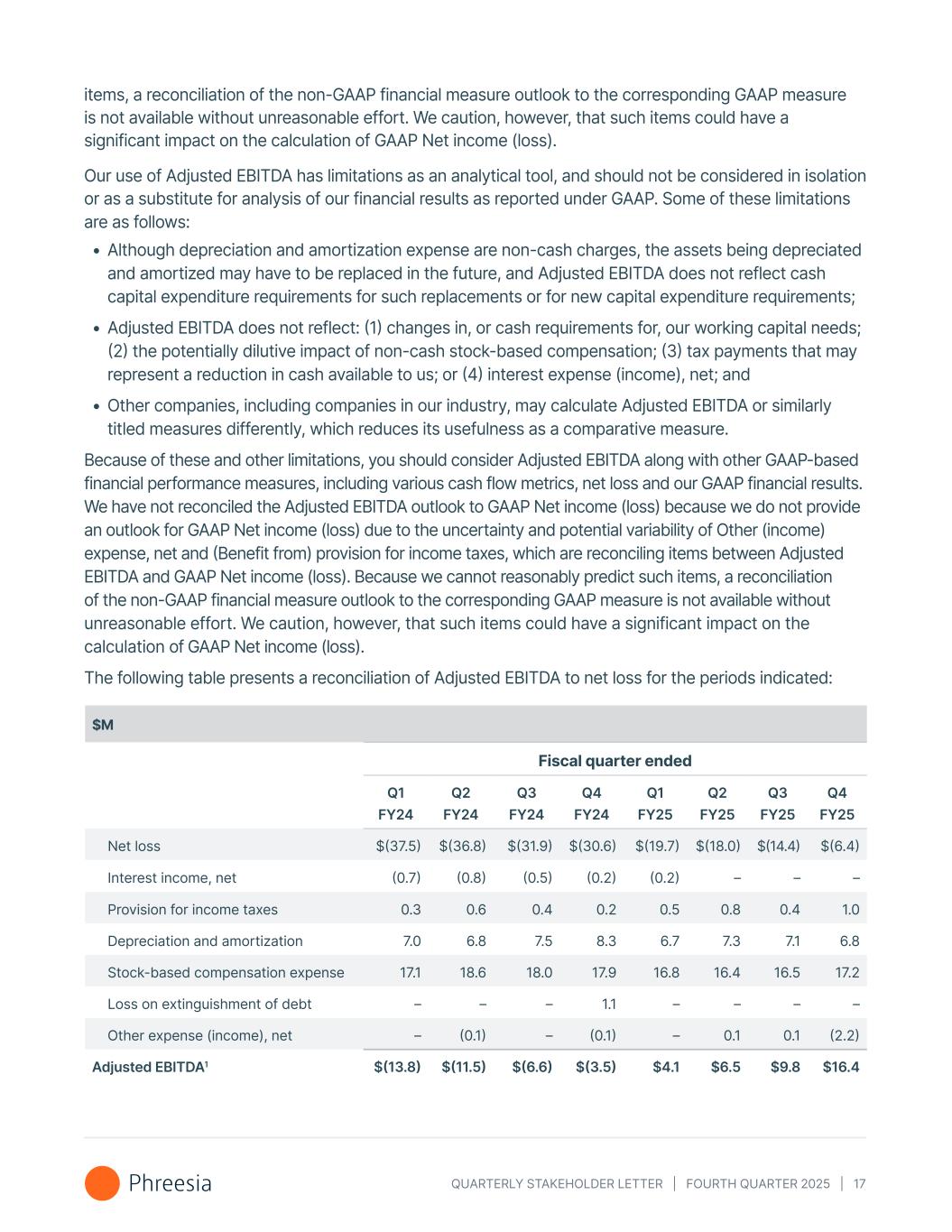
QUARTERLY STAKEHOLDER LETTER | FOURTH QUARTER 2025 | 17 items, a reconciliation of the non-GAAP financial measure outlook to the corresponding GAAP measure is not available without unreasonable effort. We caution, however, that such items could have a significant impact on the calculation of GAAP Net income (loss). Our use of Adjusted EBITDA has limitations as an analytical tool, and should not be considered in isolation or as a substitute for analysis of our financial results as reported under GAAP. Some of these limitations are as follows: • Although depreciation and amortization expense are non-cash charges, the assets being depreciated and amortized may have to be replaced in the future, and Adjusted EBITDA does not reflect cash capital expenditure requirements for such replacements or for new capital expenditure requirements; • Adjusted EBITDA does not reflect: (1) changes in, or cash requirements for, our working capital needs; (2) the potentially dilutive impact of non-cash stock-based compensation; (3) tax payments that may represent a reduction in cash available to us; or (4) interest expense (income), net; and • Other companies, including companies in our industry, may calculate Adjusted EBITDA or similarly titled measures differently, which reduces its usefulness as a comparative measure. Because of these and other limitations, you should consider Adjusted EBITDA along with other GAAP-based financial performance measures, including various cash flow metrics, net loss and our GAAP financial results. We have not reconciled the Adjusted EBITDA outlook to GAAP Net income (loss) because we do not provide an outlook for GAAP Net income (loss) due to the uncertainty and potential variability of Other (income) expense, net and (Benefit from) provision for income taxes, which are reconciling items between Adjusted EBITDA and GAAP Net income (loss). Because we cannot reasonably predict such items, a reconciliation of the non-GAAP financial measure outlook to the corresponding GAAP measure is not available without unreasonable effort. We caution, however, that such items could have a significant impact on the calculation of GAAP Net income (loss). The following table presents a reconciliation of Adjusted EBITDA to net loss for the periods indicated: $M Fiscal quarter ended Q1 FY24 Q2 FY24 Q3 FY24 Q4 FY24 Q1 FY25 Q2 FY25 Q3 FY25 Q4 FY25 Net loss $(37.5) $(36.8) $(31.9) $(30.6) $(19.7) $(18.0) $(14.4) $(6.4) Interest income, net (0.7) (0.8) (0.5) (0.2) (0.2) – – – Provision for income taxes 0.3 0.6 0.4 0.2 0.5 0.8 0.4 1.0 Depreciation and amortization 7.0 6.8 7.5 8.3 6.7 7.3 7.1 6.8 Stock-based compensation expense 17.1 18.6 18.0 17.9 16.8 16.4 16.5 17.2 Loss on extinguishment of debt – – – 1.1 – – – – Other expense (income), net – (0.1) – (0.1) – 0.1 0.1 (2.2) Adjusted EBITDA1 $(13.8) $(11.5) $(6.6) $(3.5) $4.1 $6.5 $9.8 $16.4
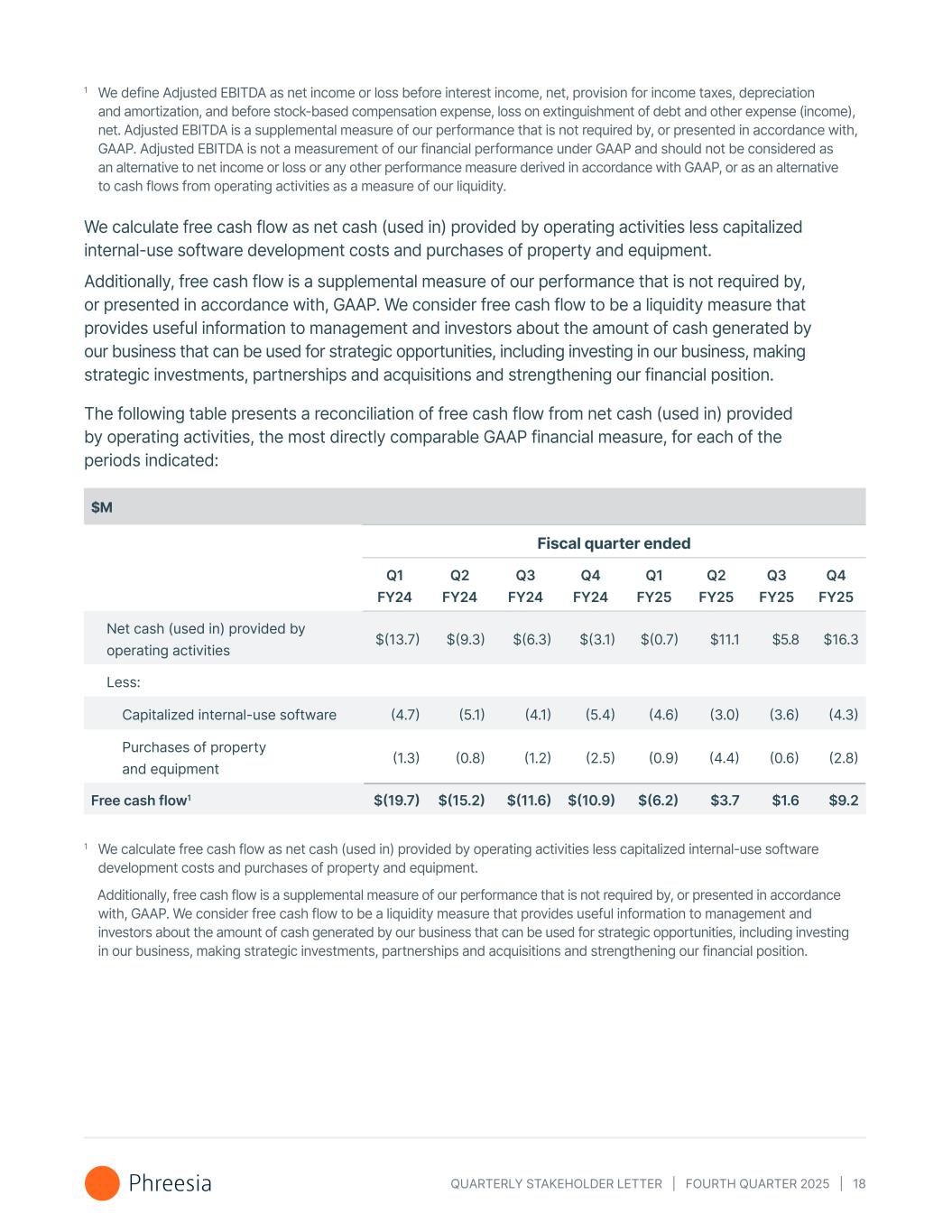
QUARTERLY STAKEHOLDER LETTER | FOURTH QUARTER 2025 | 18 We calculate free cash flow as net cash (used in) provided by operating activities less capitalized internal-use software development costs and purchases of property and equipment. Additionally, free cash flow is a supplemental measure of our performance that is not required by, or presented in accordance with, GAAP. We consider free cash flow to be a liquidity measure that provides useful information to management and investors about the amount of cash generated by our business that can be used for strategic opportunities, including investing in our business, making strategic investments, partnerships and acquisitions and strengthening our financial position. The following table presents a reconciliation of free cash flow from net cash (used in) provided by operating activities, the most directly comparable GAAP financial measure, for each of the periods indicated: $M Fiscal quarter ended Q1 FY24 Q2 FY24 Q3 FY24 Q4 FY24 Q1 FY25 Q2 FY25 Q3 FY25 Q4 FY25 Net cash (used in) provided by operating activities $(13.7) $(9.3) $(6.3) $(3.1) $(0.7) $11.1 $5.8 $16.3 Less: Capitalized internal-use software (4.7) (5.1) (4.1) (5.4) (4.6) (3.0) (3.6) (4.3) Purchases of property and equipment (1.3) (0.8) (1.2) (2.5) (0.9) (4.4) (0.6) (2.8) Free cash flow1 $(19.7) $(15.2) $(11.6) $(10.9) $(6.2) $3.7 $1.6 $9.2 1 We define Adjusted EBITDA as net income or loss before interest income, net, provision for income taxes, depreciation and amortization, and before stock-based compensation expense, loss on extinguishment of debt and other expense (income), net. Adjusted EBITDA is a supplemental measure of our performance that is not required by, or presented in accordance with, GAAP. Adjusted EBITDA is not a measurement of our financial performance under GAAP and should not be considered as an alternative to net income or loss or any other performance measure derived in accordance with GAAP, or as an alternative to cash flows from operating activities as a measure of our liquidity. 1 We calculate free cash flow as net cash (used in) provided by operating activities less capitalized internal-use software development costs and purchases of property and equipment. Additionally, free cash flow is a supplemental measure of our performance that is not required by, or presented in accordance with, GAAP. We consider free cash flow to be a liquidity measure that provides useful information to management and investors about the amount of cash generated by our business that can be used for strategic opportunities, including investing in our business, making strategic investments, partnerships and acquisitions and strengthening our financial position.
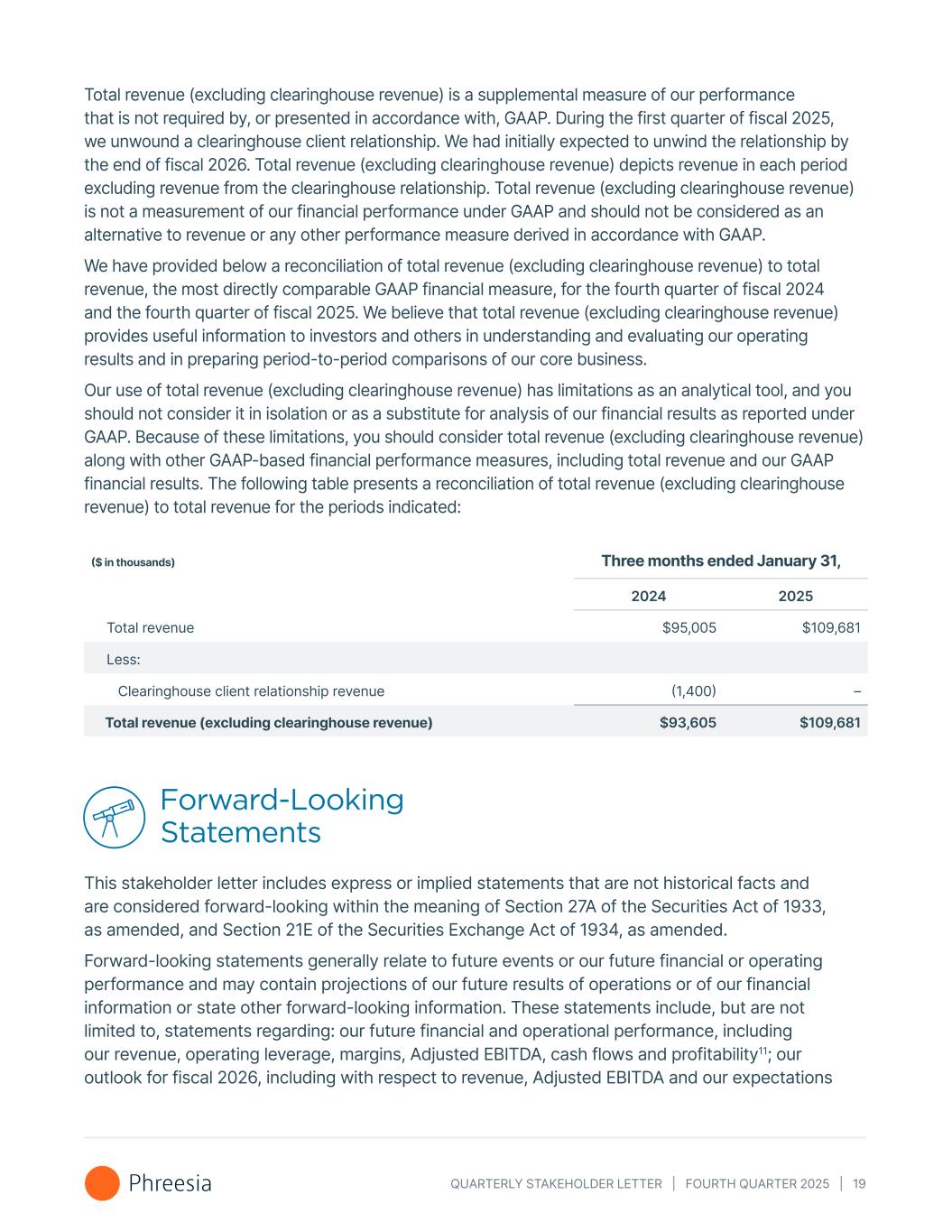
QUARTERLY STAKEHOLDER LETTER | FOURTH QUARTER 2025 | 19 Total revenue (excluding clearinghouse revenue) is a supplemental measure of our performance that is not required by, or presented in accordance with, GAAP. During the first quarter of fiscal 2025, we unwound a clearinghouse client relationship. We had initially expected to unwind the relationship by the end of fiscal 2026. Total revenue (excluding clearinghouse revenue) depicts revenue in each period excluding revenue from the clearinghouse relationship. Total revenue (excluding clearinghouse revenue) is not a measurement of our financial performance under GAAP and should not be considered as an alternative to revenue or any other performance measure derived in accordance with GAAP. We have provided below a reconciliation of total revenue (excluding clearinghouse revenue) to total revenue, the most directly comparable GAAP financial measure, for the fourth quarter of fiscal 2024 and the fourth quarter of fiscal 2025. We believe that total revenue (excluding clearinghouse revenue) provides useful information to investors and others in understanding and evaluating our operating results and in preparing period-to-period comparisons of our core business. Our use of total revenue (excluding clearinghouse revenue) has limitations as an analytical tool, and you should not consider it in isolation or as a substitute for analysis of our financial results as reported under GAAP. Because of these limitations, you should consider total revenue (excluding clearinghouse revenue) along with other GAAP-based financial performance measures, including total revenue and our GAAP financial results. The following table presents a reconciliation of total revenue (excluding clearinghouse revenue) to total revenue for the periods indicated: ($ in thousands) Three months ended January 31, 2024 2025 Total revenue $95,005 $109,681 Less: Clearinghouse client relationship revenue (1,400) – Total revenue (excluding clearinghouse revenue) $93,605 $109,681 Forward-Looking Statements This stakeholder letter includes express or implied statements that are not historical facts and are considered forward-looking within the meaning of Section 27A of the Securities Act of 1933, as amended, and Section 21E of the Securities Exchange Act of 1934, as amended. Forward-looking statements generally relate to future events or our future financial or operating performance and may contain projections of our future results of operations or of our financial information or state other forward-looking information. These statements include, but are not limited to, statements regarding: our future financial and operational performance, including our revenue, operating leverage, margins, Adjusted EBITDA, cash flows and profitability11; our outlook for fiscal 2026, including with respect to revenue, Adjusted EBITDA and our expectations
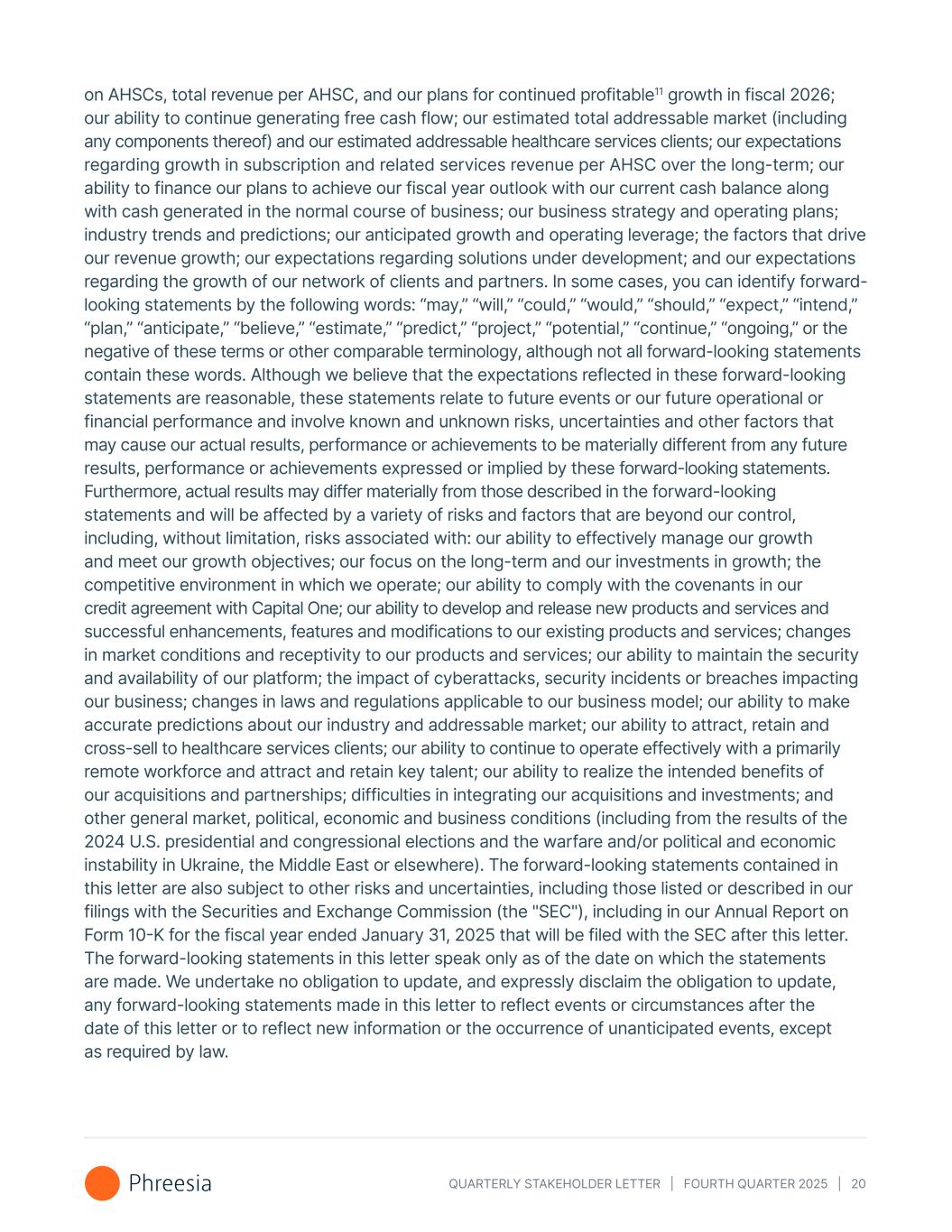
QUARTERLY STAKEHOLDER LETTER | FOURTH QUARTER 2025 | 20 on AHSCs, total revenue per AHSC, and our plans for continued profitable11 growth in fiscal 2026; our ability to continue generating free cash flow; our estimated total addressable market (including any components thereof) and our estimated addressable healthcare services clients; our expectations regarding growth in subscription and related services revenue per AHSC over the long-term; our ability to finance our plans to achieve our fiscal year outlook with our current cash balance along with cash generated in the normal course of business; our business strategy and operating plans; industry trends and predictions; our anticipated growth and operating leverage; the factors that drive our revenue growth; our expectations regarding solutions under development; and our expectations regarding the growth of our network of clients and partners. In some cases, you can identify forward- looking statements by the following words: “may,” “will,” “could,” “would,” “should,” “expect,” “intend,” “plan,” “anticipate,” “believe,” “estimate,” “predict,” “project,” “potential,” “continue,” “ongoing,” or the negative of these terms or other comparable terminology, although not all forward-looking statements contain these words. Although we believe that the expectations reflected in these forward-looking statements are reasonable, these statements relate to future events or our future operational or financial performance and involve known and unknown risks, uncertainties and other factors that may cause our actual results, performance or achievements to be materially different from any future results, performance or achievements expressed or implied by these forward-looking statements. Furthermore, actual results may differ materially from those described in the forward-looking statements and will be affected by a variety of risks and factors that are beyond our control, including, without limitation, risks associated with: our ability to effectively manage our growth and meet our growth objectives; our focus on the long-term and our investments in growth; the competitive environment in which we operate; our ability to comply with the covenants in our credit agreement with Capital One; our ability to develop and release new products and services and successful enhancements, features and modifications to our existing products and services; changes in market conditions and receptivity to our products and services; our ability to maintain the security and availability of our platform; the impact of cyberattacks, security incidents or breaches impacting our business; changes in laws and regulations applicable to our business model; our ability to make accurate predictions about our industry and addressable market; our ability to attract, retain and cross-sell to healthcare services clients; our ability to continue to operate effectively with a primarily remote workforce and attract and retain key talent; our ability to realize the intended benefits of our acquisitions and partnerships; difficulties in integrating our acquisitions and investments; and other general market, political, economic and business conditions (including from the results of the 2024 U.S. presidential and congressional elections and the warfare and/or political and economic instability in Ukraine, the Middle East or elsewhere). The forward-looking statements contained in this letter are also subject to other risks and uncertainties, including those listed or described in our filings with the Securities and Exchange Commission (the "SEC"), including in our Annual Report on Form 10-K for the fiscal year ended January 31, 2025 that will be filed with the SEC after this letter. The forward-looking statements in this letter speak only as of the date on which the statements are made. We undertake no obligation to update, and expressly disclaim the obligation to update, any forward-looking statements made in this letter to reflect events or circumstances after the date of this letter or to reflect new information or the occurrence of unanticipated events, except as required by law.
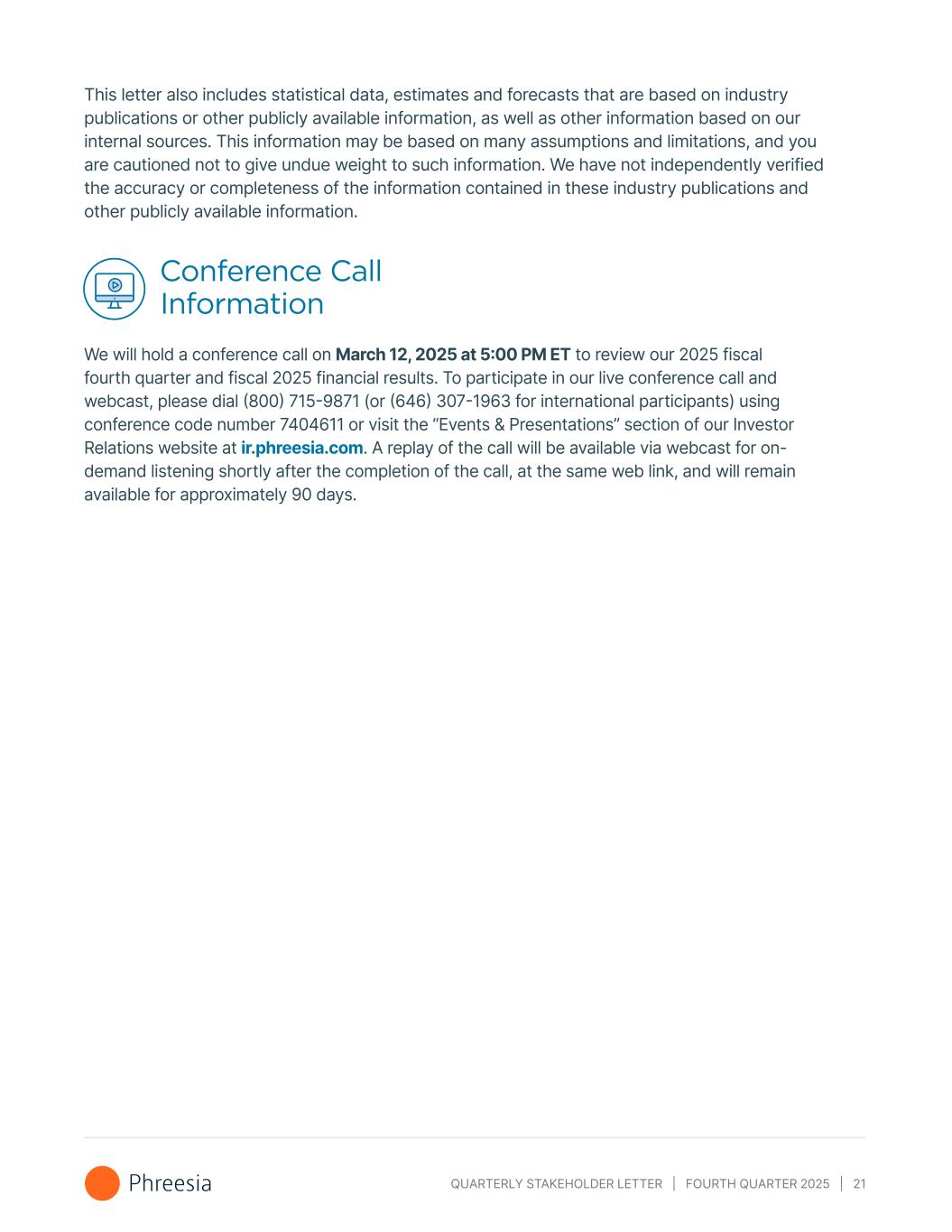
QUARTERLY STAKEHOLDER LETTER | FOURTH QUARTER 2025 | 21 This letter also includes statistical data, estimates and forecasts that are based on industry publications or other publicly available information, as well as other information based on our internal sources. This information may be based on many assumptions and limitations, and you are cautioned not to give undue weight to such information. We have not independently verified the accuracy or completeness of the information contained in these industry publications and other publicly available information. Conference Call Information We will hold a conference call on March 12, 2025 at 5:00 PM ET to review our 2025 fiscal fourth quarter and fiscal 2025 financial results. To participate in our live conference call and webcast, please dial (800) 715-9871 (or (646) 307-1963 for international participants) using conference code number 7404611 or visit the “Events & Presentations” section of our Investor Relations website at ir.phreesia.com. A replay of the call will be available via webcast for on- demand listening shortly after the completion of the call, at the same web link, and will remain available for approximately 90 days.
